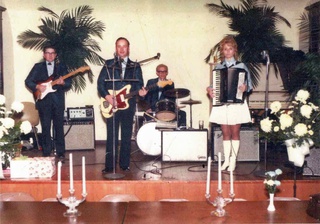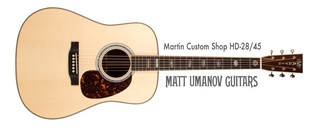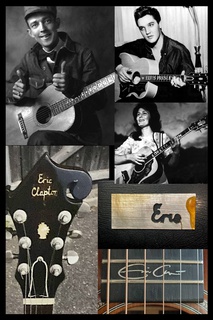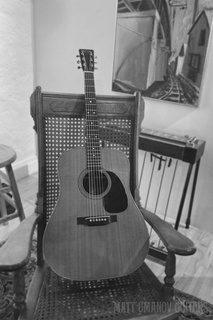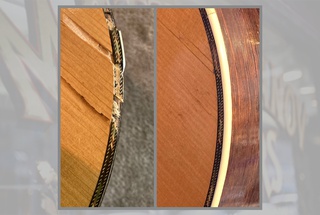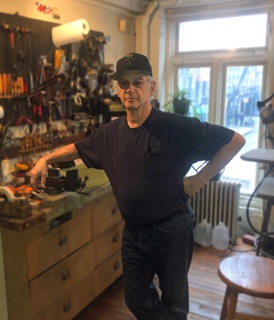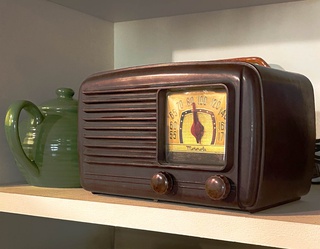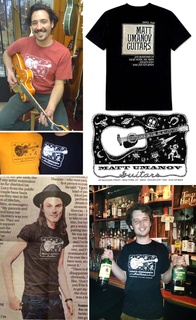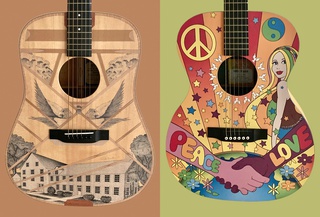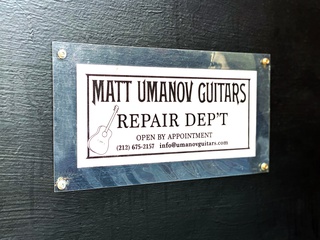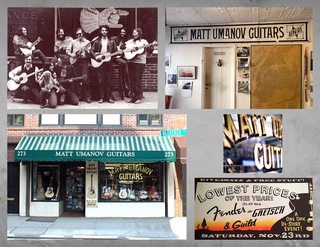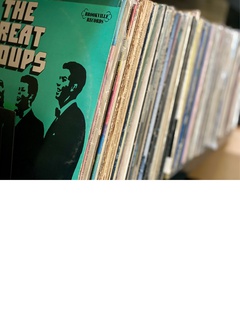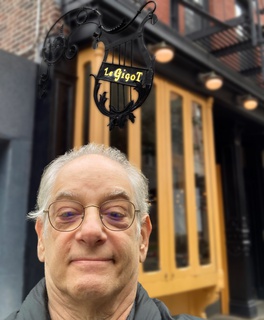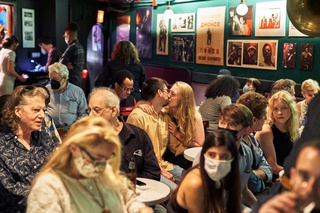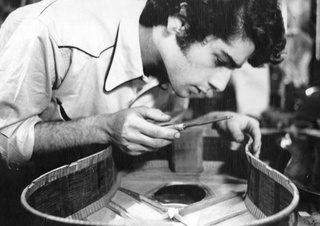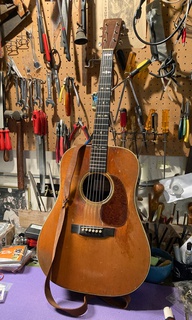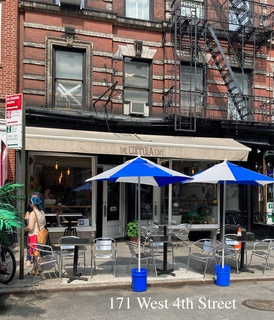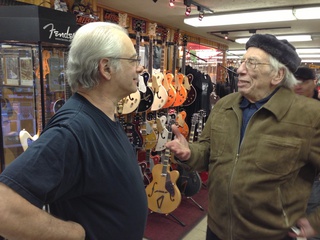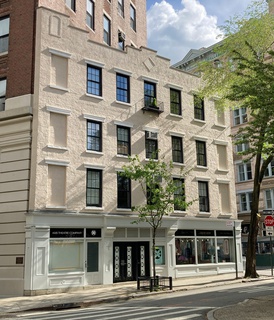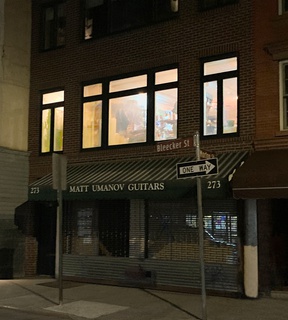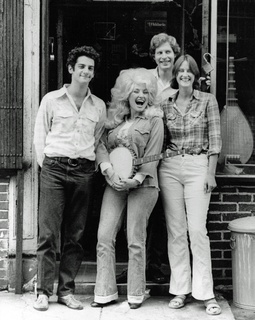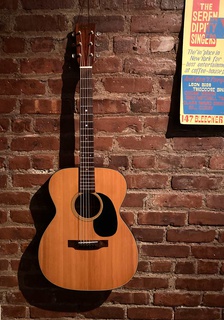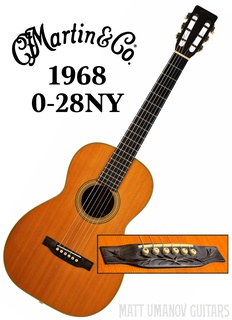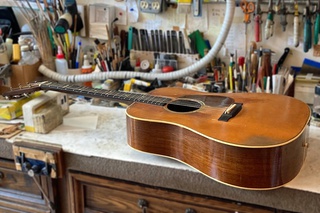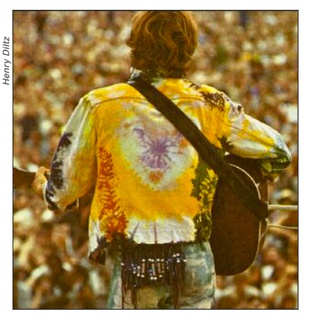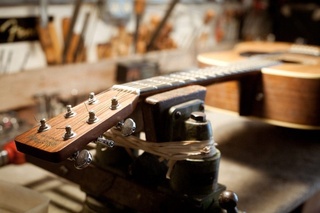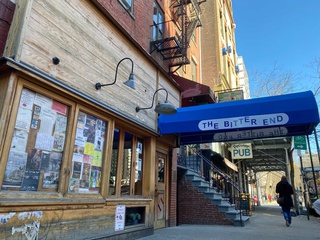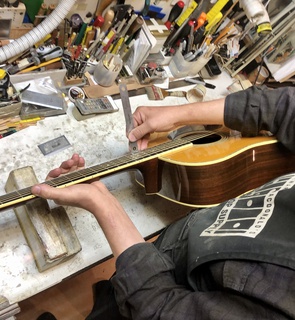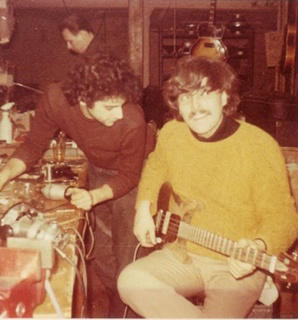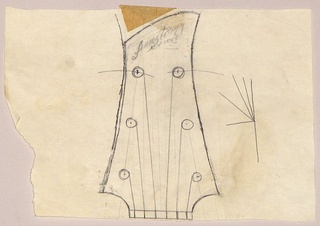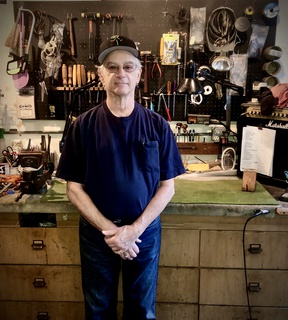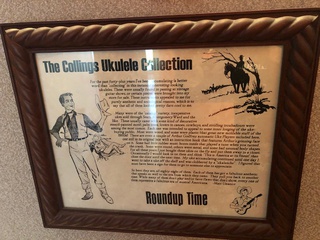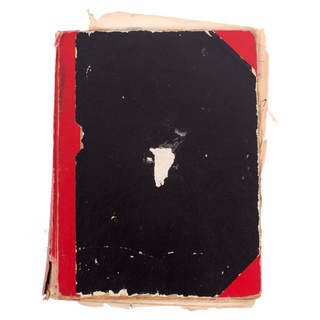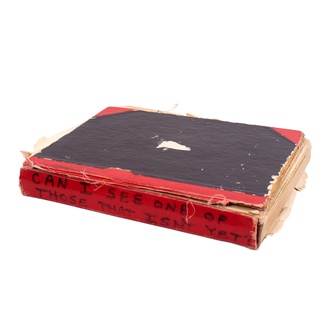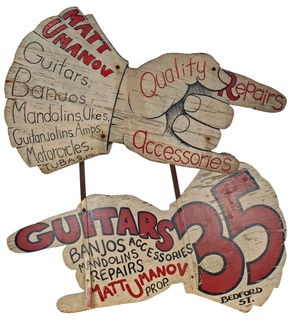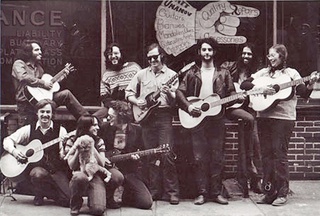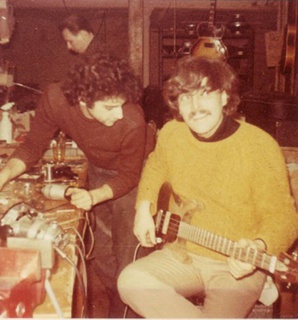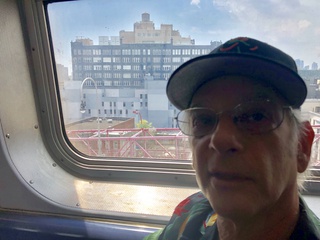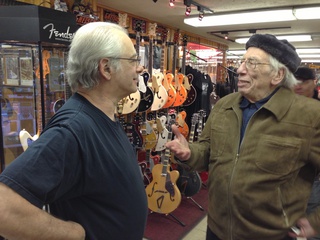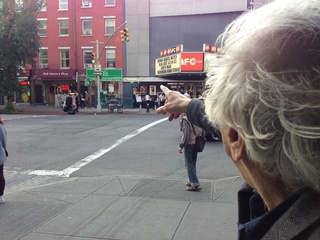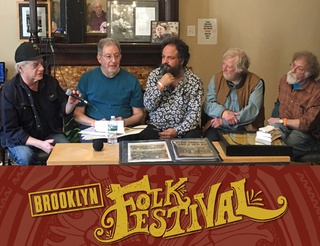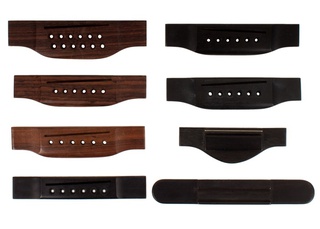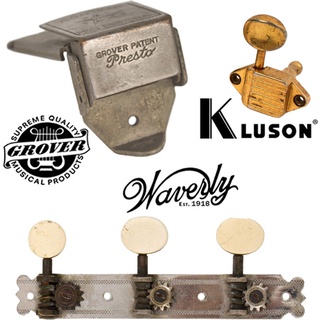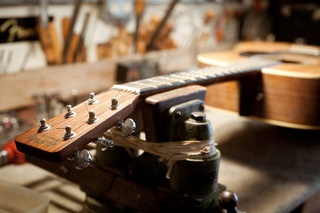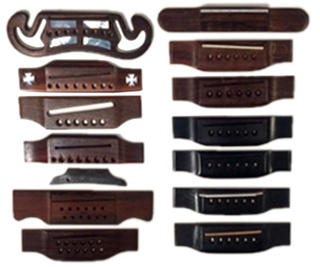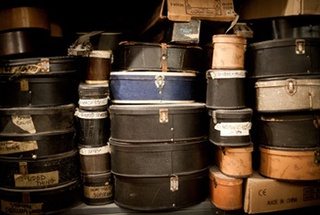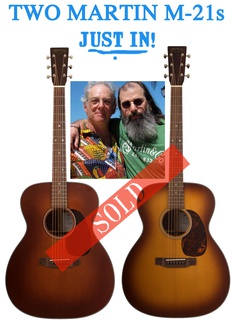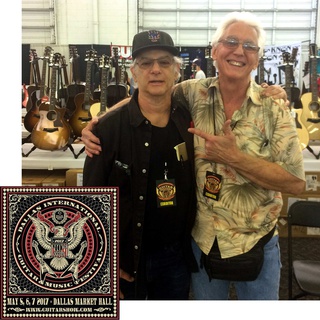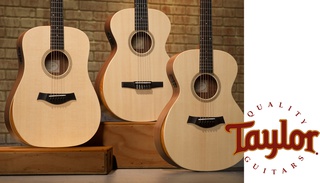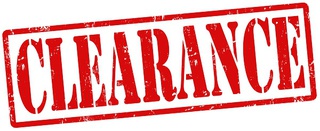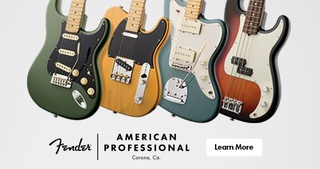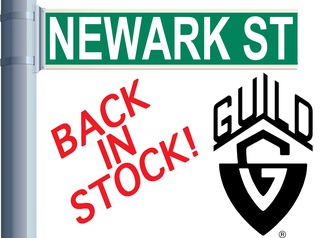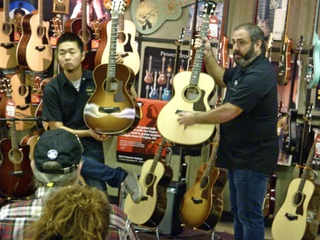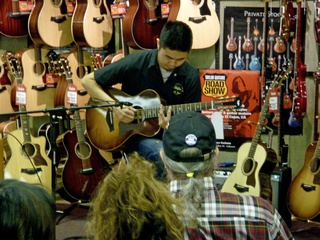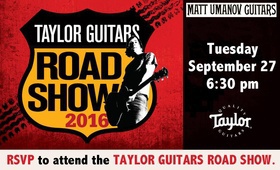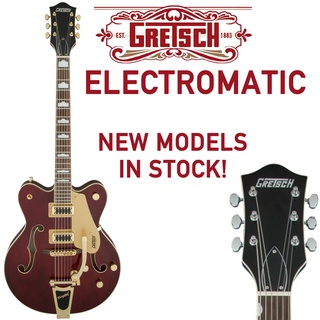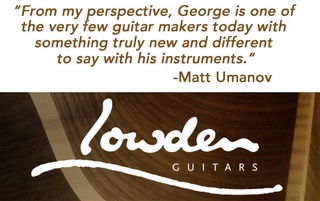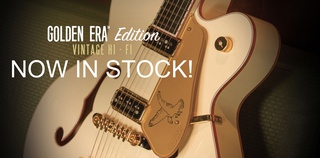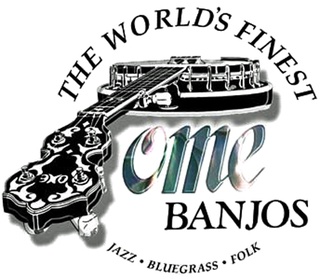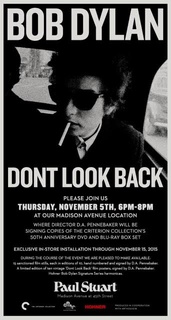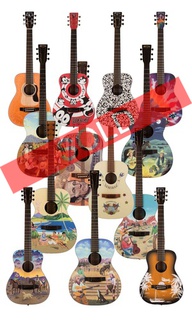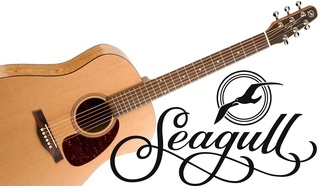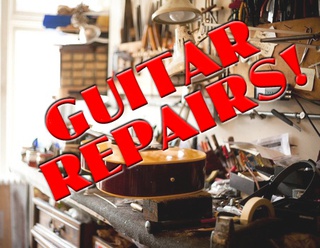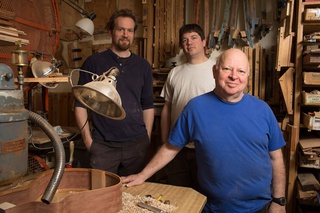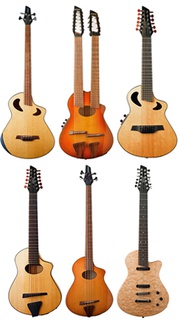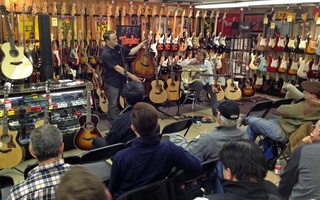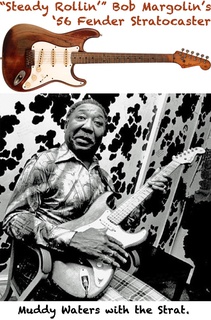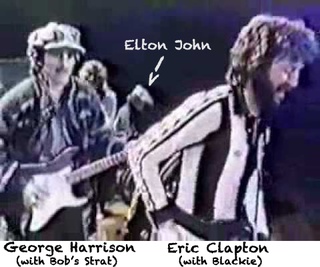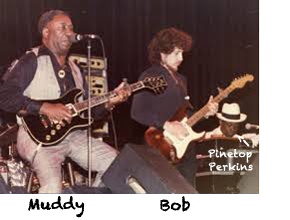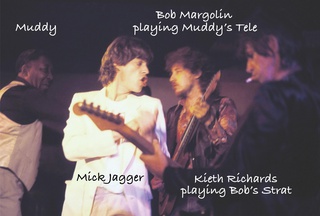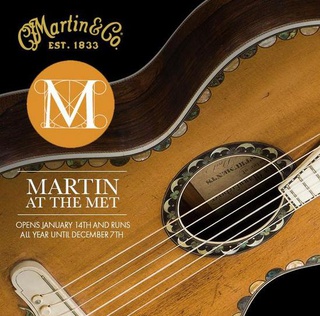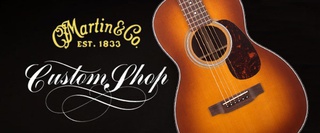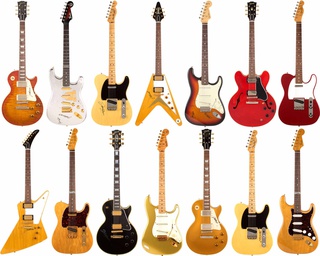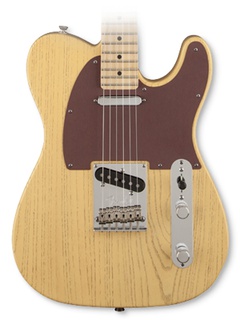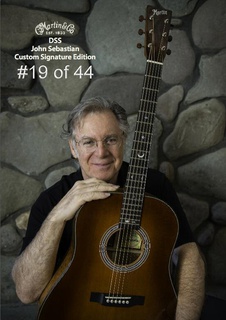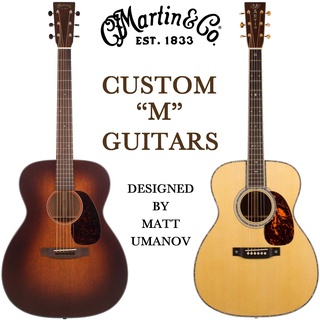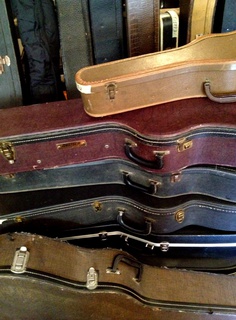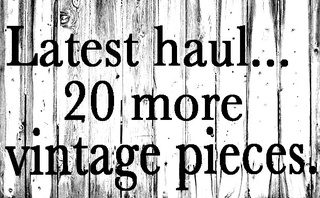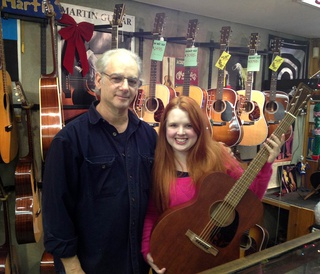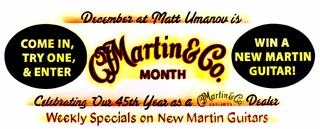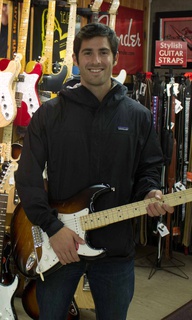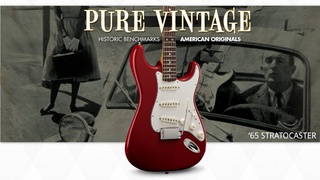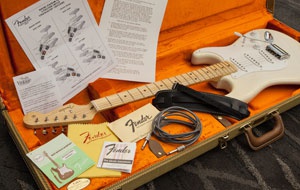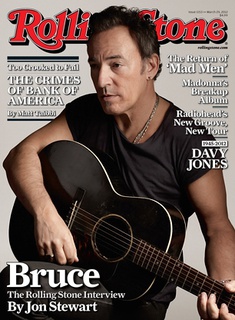
I rarely consider the arrival of any particular guitar here “news” but this one touched on so many places that I felt it warranted something special. To start, how it came to me. For the last five years that I had my walk-in store open (out of forty-eight), up until 2017, my Fender rep was Tim Penn, as fine a person in every way as you could ever hope to know. Tim and I became great friends outside of our business dealings to the point where he was invited to stay with us in the house that four other guitar makers and I rented every year during the Woodstock Luthiers Invitational, Tim being the only person who worked “in the industry" that we ever welcomed into our family. When I recently mentioned to Tim that I was looking for guitars for an upcoming emailing he immediately said “Hey, I got some at home for you!”. One was a 1960 Fender Jazzmaster that had come to him from a relative of a friend of a relative of someone else from who-knows-where. Like they say, it had that certain "Je ne sais quoi but I don't know what it is", and I immediately loved it. Body refinished in the right color with the right stuff, the rest of it all original and showing just the right amount of six decades of gentle playing wear. You look at it and go “Yes!”, you pick it up and start to get excited, and when you plug it in you just sigh.
Turned out that it needed some coaxing to get it to play right and while I don't do this kind of thing very much anymore, leave most of it to my main man here, I was all over this Fender like white on rice. A mechanical challenge! My true love! So on to the somewhat balky jack, easy stuff. Next a few uneven frets, time-consmuing but doable. Then……. those few danged saddle-height adjustment screws that had got frozen in place real good from years and years of sweat from someone’s right hand rubbing all over the bridge. This turned out to be several hours worth of work but took me right back to my days of restoring old motorcycle and car engines, true machine shop stuff that I love doing and fortunately I still had all the right tools, and also replacement parts from our days here as a top Fender service center. And then, ulp, wouldn't you know it, that wacky and wonderful, unique tremolo system found only on Fender Jazzmasters and Jaguars, spoke up, smartly, said to me “Nope". Been years sine I had fooled with these and I know quite well how they're sposeta work (many folks do not), but who could remember how to coerce them into proper behavior? After too much head-scratching and experimental screw-turning, I finally admitted to what my brother-in-law, a noted physicist, calls “ RTFM”, which stands for “Read the f****ing manual”. And so online I went, not my usual MO, and there it was, and I had it all up and running smoothly in fifteen minutes.
And now for the capper. I had passed right over some papers that were in the guitar's case and among them I now noticed a photo of the original owner, or some early owner, playing the Jazzmaster in a four-piece what-looks-like-some-local wedding band. There he was, front and center, and the rhythm guitar player just behind him with a Strat, the drummer in the back, and both of those two wearing thick glasses and looking pretty geeky. BUT…..a tall, red-headed young lady accordion player! Wearing a white miniskirt and white go-go boots! The total package! Early 1960s perfection personified, the whole band! I gotta tell ya, this made my day, even made my week. Some days you just never know.
Back in the 1970s, both early and late, when I was near the end of being at my first store location and well into the second, I had some ideas for a few very special Martin guitars but in those days they had no custom shop and were not taking special orders of any kind, from no one, nohow. OTOH, I had a very special relationship with Martin going back to the early 1960s, had known and had the pleasure of meeting and doing business with CF Martin III, who ran the company from the 1930s until he passed away in the 1980s. I had become a Martin dealer in 1969 and had made many good friends there in sales, in management, in production, and more, having visited the factory many many times. And so when upper-echelon sales said “No way” to a few of my requests I went, um, over a few heads, was persuasive as it were, maybe even was more of a pest, but I got it done, in style, more than once.
Hard to remember the sequence after so many years but one of the projects seemed simple enough: Take a standard HD-28 body but change the soundhole rosette to that of a D-45 and put on a full-tilt D-45 neck. Simple, and rather elegant if I do say so myself. I seem to recall ordering four of them, maybe two more a few years later, and doing a reprise many many years later, perhaps in the 2000s, when “custom" was no object. One of those 1970s guitars went to Johnny Cash who, along with his wife June Carter, always stopped by when they were in town.
The second project was more of a corker. Martin had had the D-45 in their standard lineup since the late 1960s but that was it for pearl-inlaid models. What I wanted was a 000-45. This was in the 1970s and it seemed simple enough: take some D-45 wood, make it into a 000, give it the “45" treatment, and voila´. Some wiseguy in sales said “No way but if you want SIX of them…….”. Being an even bigger wiseguy I said "Sure, and can you mix up a few minor specs on them?” After they agreed I hit ‘em with the order. Three 12-fret versions with slotted pegheads; one with no fingerboard inlay, another like it but with hexagon fingerboard inlays, and another like that but with a sunburst finish on the top. And three more like those, but with 14-ffret necks. Beats me why they said yes but they did, and all six turned out to be fabulous guitars. All had standard construction specs of the day; no scalloped bracing, none of that stuff, just regular Martin building style was fine with me. I don’t recall where they all went but I do know that one got traded for a few other guitars, and the 12-fret sunburst one went to my old friend Artie Traum. At some point Artie decided that he had more guitars than he really needed, and that one came back to me. It went to Steve Earle, who still has it, and treasures it.
Coda to the story. One day in the 1990s, when one of those 000 guitars was in my store for sale and another in for repairs, two separate people who had bought others years before happened to walk in, carrying them. Four out of the six co-incidentally back at my place all at once? What are the chances of that? I call it Kismet.
How many of us remember the guitars our cowboy songsters played so proudly, and visibly, when we were younger? Or those of us who aren't quite of that age but couldn't help noticing those flashy instruments with the artists' names writ LARGE in mother-of-pearl on the fingerboards? The most visible one I can remember from when I was maybe ten years old, in the 1950s, was Gene Autry's, didn’t get much bigger than Gene as a movie-star singing cowboy and his Martin D-45 had his name oh-so prominently inlaid on the fingerboard. Possibly the very first to do that was Jimmie Rogers, the original Singing Brakeman from the late 1920s (Blue Yodel # 9, Waiting For A Train, so many more classics), whose Martin 000-45 had his name on the fingerboard in large pearl block letters. Martin has since made re-issue copies of both of those historic instruments. And I can think of so many more: Eddie Arnold with his J-200; Loretta Lynn carrying on the tradition with her Epiphone Excellente (Rest in peace, Loretta). And more. And more. Then there was the country-blues singer from Alabama who worked in my store in the 1970s-80s, for whom I ordered a custom Martin Style-5 uke (all that abalone trim!) in complete black lacquer, with his name, LJ Henry, in mother-of-pearl script on the fingerboard. Years later he apparently had to sell it and it came into the hands of a dealer I knew, who just couldn’t live with that fingerboard and replaced it, a practice I am vehemently opposed to as it is “part of the story” and who are we to deign to eradicate that story? A coda to the story though is that my dealer friend gave me that inlaid fingerboard and it sits on my desk to this day. And then…….there’s my own, ahem, entry into that world when I was maybe twenty years old, around 1967-8, the whiz kid guitar restoration and repair person here in NYC, years before I had opened my store, and of course knew that I knew everything. My good friend Danny Armstrong, a bit older than me and pals with all the rock stars of the day, knew my capabilities so when Eric Clapton came to him with a treasured 1959-or-so Les Paul with a hopelessly smashed peghead, Danny knew that I was the absolute best person in New York most qualified to somehow make the guitar whole and usable again, and he gave it to me to do the job. Being somewhat um, brash, I asked Danny if it would be OK to get a bit creative with the project and he said "Sure!”. So being very steeped in pre-war American acoustic instruments, I of course made and grafted on a peghead just like the asymmetreical ones on pre-war Gibson F-5 mandolins. Of course. And it seemed quite logical to me, where the mandolins had had a “The Gibson” logo inlaid in script pearl, to put “Eric Clapton” there, in script pearl. Of course. You can see a picture of it on P. 14 of Vic Da Pra’s fabulous book “Burst Believers II”, all about those earlier sunburst Les Pauls. And I still have the piece of pearl from which I cut out the word “Eric”. And so up to date, right now today, here we are with a Martin Eric Clapton Signature model 000-28EC with Eric's signature in script pearl, inlaid at the end of the fingerboard. Thing is, back then this stuff was all done by hand, with little saws and teeny files and such one at a time but today, what with laser cutters(!) driven by computers(!), those things can be cranked out in minutes, exactly the same, every time. Sometimes it's hard to admit progress, much as we revere the old-time ways.
Sometime in 2011 I was contacted by a woman named Julie to have our repair department thoroughly go over a 1952 Martin D-28, which had been her father’s. The guitar had not been played or looked at for many years as her father had long since passed away, and she wanted to make sure that it was in top shape and have any work needed done by us. We did so for her, and she then put the guitar away again until contacting me recently that it was finally time for her dad’s treasured Martin to have a new, very appreciative home and have music made with it once again as she was not a player herself. She was very specific in wanting only us to be its caretaker and finder of a new, caring owner, and I was quite flattered. I was especially taken with what she wrote to me, without being asked to do so, regarding the history of the guitar and her family’s and especially her Dad’s connections with it. I am always impressed by quality writing, and what what she wrote and how she put it literally made my morning, from someone who really knows how to express herself with words and in her writing style. Being so articulate just seemed to come naturally to her and when I asked if she was a writer by profession she seemed to pass the question by.
Julie and her husband were living in NYC back in 2011 but have since moved upstate, and it took quite a bit of maneuvering among a few different people to get the guitar here but here it now is. Below is the story she sent me, verbatim, regarding the relationship between her family and her Dad and his Martin over the years, followed by a bit of later back-and-forth between us. I have rarely, in all my years, been so taken with the telling of a story of an instrument's history.
=======================================
"Not sure how much provenance matters, but every object has a story, especially when it is cherished.
My father grew up in Whitby, West Virginia, which was a coal mining town in the exact vein as the one Loretta Lynn grew up in, if you've seen the film.
All he knew when he graduated high school was that he wasn't going down in that mine. Day after graduation he hitched a ride to Wheeling and enlisted in the Air Force. That would have been 1954.
He spent his first tour of duty at Castle Air Force Base in Atwater, CA, west of San Francisco, northwest of Fresno. He loved it there. He played baseball (lefthanded first base and pitcher on some sort of semi-pro team) and played in a country western combo. The studio photo from that time shows him playing upright bass, but this is when he bought the guitar that you are helping to re-home now.
He told me many times how Martin made the very best accoustic guitars and how he had saved up for the money to put down as a deposit at a guitar shop and paid the rest on installment. If memory serves, he paid something like $275, a great deal of money to him. I feel it safe to say that aside from a house and automobiles, purchasing this guitar was the largest sum of money he ever spent.
That guitar traveled with him from duty station to duty station, and then a bit more with my mother and then me. It has travelled safely from California to Ohio, Alaska. Florida, Germany (West Germany, then), Massachusetts, Nebraska, Indiana, Rhode Island, New York City, Philadelphia, and finally the Catskills. I do wonder where it will go next.
My Father was not a great player. He played chords by ear and sang harmony. He loved to hear a new country song on the radio and pick out the chords and melody and then come ask me to identify the song. He had a closet full of Country Music Magazine, and once went to a local radio station to take a test to see if he could be a country DJ.
He died of ALS in 1995. I don't know the last time he played the guitar, but I can vividly imagine how hard it was for him to gradually lose the ability to do so.
Love of music is not something my mother and father shared. But thanks to him I was raised on the Porter Waggoner Show, progressing through the years to Austin City Limits.
What I most understand about this guitar is that it was meant to be played. Its sound is gorgeous, round and full, rich and mellow. Even just the few chords I can play sound grand.
I am grateful for the care I know you will take in helping this guitar to resume its music making life.
Julie”
=======================================
And here is a bit of our conversation after the Martin arrived here………….
"You are definitely part of this guitar's story. I don't remember how I first became aware of your shop, but when it turned out that my husband and I were going to be living in New York for a few years, I knew I'd be taking the guitar to you for evaluation and appraisal, and it seemed like some sort of destiny fulfilled in a strange way, that my convoluted life path would lead to my being able to easily get the guitar into the best possible hands. I don't believe in coincidence, but I do believe in serendipity, if that makes any sense to you.
More than a decade later now, it occurs to me that the moment seems right to ask for your help in moving it on to the next right person. My hope is that it goes to someone who will love playing it.
Anything of what I wrote that you would like to share with the new owner would be fine. My father, whose name was James Gerald Cox, would appreciate it, I believe, for the story to be known”.
=======================================
So there it is, the story, to be continued by this wonderful Martin’s next caretaker, via us to you.
My first encounter with the work of JG Schroeder, New York City guitar and violin maker ca. 1900, was in the 1970s with a most unusual guitar with his hand signed label in it. The body looked like an oddly-proportioned later 14-fret Martin 00-size, but with a very short 12-fret neck. Who designed it or for whom it was made I have no idea, but the extreme precise quality of every line, every curve, every fitting, was nothing short of eye-opening in a very refined way, Other than from two other men of German extraction who had earlier worked for Martin and then gone out on their own, I had seen this precision and understated perfection nowhere else in American guitar making. Over the ensuing 30-40 years I was fortunate enough to come across several examples of Schroeder’s guitars and a few mandolins, all of more traditional shape and size, some relatively plain and a few quite fancy, and all with the unmistakable touch in the same vein as Martin's had always been, and seen nowhere else in my experience except for those from Louis Schmidt and George Maul, the two men who had started in America by working for Martin in the 1840s.
Even though few others ever achieved quite this level in American guitar making (though there was also, with about 90% of it, Henry Schatz of Boston, another former Martin associate), its importance cannot be overlooked. The high commitment to and success in combining clean lines and perfectly fit parts, both aesthetically and structurally, both outside and inside of a creation, is rare indeed. Martin has carried it out to this day, and testimony to this is that literally every steel-string guitar made anywhere in the world has as its structural basis designs Martin worked out in the late-1850s. Interestingly, of all of the 19th-century American guitar makers whose work survives, Martin, Schmidt and Maul, and Schroeder are practically the only ones in whose instruments we can see the mark of a name-branding iron. Here is JG Schroeder pictured in his shop in the only known photo of him. Note the mandolin necks on a shelf in the upper right corner. I would welcome anyone finding for me one of his signed violins.
Click here for a first-hand account of how Matt acquired this picture of J.G. Schroeder as well as his name branding iron.
We were recently sent, by a customer from another state, one of the loveliest Martin guitars we’ve seen in quite some time. It is a 00-30, made in 1903, a brief time period of ten years or so when Martin guitars were built to the very lightest specs they ever had been, before or since. The top, back, and sides from that era are extraordinarily thin and lightweight, and the Cuban cedar Martin used for necks until 1915-20 or so was comparably light in weight. Overall, a true featherweight Martin, and all the more delightful for it. Body size 00 was and still is known as Grand Concert; Style 30 is another story. It is a bit above what became well-known as Style 28, with the herringbone top trim and back center-strip that Martin resurrected to great popularity in the 1970s. What sets the Style 30 above that are: intricate, multicolored top marquetry far more complex than herringbone; a multicolored back center-strip as later used on Style 45 Martins; a few abalone or Japan pearl fingerboard inlays, also as later used on Style 45 guitars though not quite as many; and an abalone shell soundhole rosette. Additionally, Martins of grade 28 and higher in those days had white top and back bindings, which they still do, but made then from real ivory as opposed to the synthetics they started using around 1920, and to this day.
This beautiful Martin, when acquired by its present owner not too many years ago, was in 100% original condition with no issues and no repairs ever having been done nor needed. Unfortunately, while in his possession it was dropped on a hard floor and one side split open but much worse, it had been dropped on its edge and the top split, a piece of top broken out, and worst of all, several inches of that gorgeous intricate top marquetry and its attendant ivory binding smashed off. Sad to say, none of the missing bits or pieces of marquetry, top, or ivory binding got saved. Our job was to repair, re-create, replace and restore all affected areas. It took several months and we got the job done, this while dealing with all the “regular” jobs of acoustic and electric guitar repair, action work, etc. coming in, and everything else we’ve encountered daily here for nearly sixty years.
The first steps were cleaning out the splinters, re-positioning all that had got knocked out of place, and getting everything structurally sound, especially the laterally-split portions of top. This was followed by finding a matching piece of spruce from among our collection of old wrecks, some as old as this Martin, to replace the piece of top that had been lost. Then came the really intricate part, duplicating the multicolored top marquetry, that part containing literally hundreds of tiny different-colored parallelograms and black and white lines. Getting the colors to match the 100-year-old faded originals took a bit of doing. I need to give credit here to the people who helped with this, a company that had been created years ago by one of my very best friends to make marquetry for the guitar industry, and who has since become the foremost world-wide supplier of same for top-quality builders, domestic and foreign. While they do not normally take on small custom jobs for individuals, they assisted in this project as a personal favor to me. The last hurdle to overcome was the ivory binding; sourcing, shaping, bending, and fitting it. I won’t bore you with the details here but it was a slow process. Lastly came finish touch-up. Martins of that era were varnished and touching up areas without having them jump out as “re-done” is a skill, or more like an art, in itself.
When the job was finally completed we were quite pleased with the results, as was the customer. We were thrilled and honored to have been asked to take on this job.
Guitar repairs. I love this. It means bringing an instrument back to its best for playability in order to make music, which is really what this is all about. When you make music you are expressing yourself, always a great thing for all of us. Instrument repairs might mean correcting the effects of time and usage (It sure has been played!), or it might be correcting the result of long storage or neglect (!), or wires that came loose, or anything up to and including disaster (It got dropped!). It is so gratifying to hand people back their instruments, see the look of joy on their faces when they’ve got their much-loved guitar back, and it's whole again! Or even better than whole! I was the kind of four-year-old kid who took apart the alarm clock, put it back together and it worked, always been thrilled with making stuff work right. With the added good fortune of a family musical background, this translated right on up to my repairing banjos and guitars as a teenager and on to opening my store in 1969, where I also was the chief repair person for about the next 10-15 years.
And we're still at it here, doing repairs and restorations just as they’ve been done all over the world for centuries. Of course there have been some improvements made along the way but they’ve mostly been in the areas of specialized tools for specialized procedures, and jigs and fixtures and the like. What cannot be gotten anywhere else is what’s gained from the experience of having done this kind of work for a very long time. Knowing your woods and their predilections, knowing your techniques, and especially having a keen innate sense of the organic physical relationship of components to each other and how things move, or not. Most of our hand tools have been here for fifty years and more. The drill press and bench grinder I got in 1967 are still in use and can't be beat. A few hammers and screwdrivers I've had since forever I'd never give up; using them is like having a perfect extension of one's own arm and hand.
We’ve seen a heck of a lot of wildly different repair situations come in over the fifty-plus years we’ve been at this. Everything from simple worn-out frets (“Why won't it play right?”) to gorgeous vintage acoustic guitars seriously traumatized by fits of passion. Yep, we got ‘em all back to beautiful 100%. This is where having acquired factory parts over the years that are no longer available can give a huge advantage. Having saved sections of otherwise useless smashed older guitars from years ago can also be a great source for segments of wood to use in restoring vintage guitars. We did that very thing on a 1903 Martin recently which had losted a piece of its top in someone's fit of pique. Then there’s also dealing with misguided "custom" wiring jobs (Why won’t it work?), just love making that stuff go again. Ain't no substitute for time and experience.
There are some ways of doing things that just cannot be improved by technology. One of them, for me, is listening to a baseball game on my early-1950s all-tube kitchen-shelf radio. There's a warmth to the tone that just says “Baseball!” to me, and I love it, dearly. Making the sound ultra-clean with hi-fi equipment, which can definitely be great for certain things, just doesn’t work for a ballgame on the radio. I tune in the Mets or Yankees on my old Motorola and I am there, occasional crackle and all. So it is for me with music too. Doc Watson, Chet Atkins, Wes Montgomery, on an MP3? Nothing in the world quite like vinyl, and companion sales of vinyl for modern recordings have surged in recent years, which says a lot.
Guitar repair and guitar making definitely have their parallels here. CNC (computer numeric controlled) machinery does have its place in guitar making but the final little cuts to make it all come together, that's where the hand-fitting comes into play and becomes part of the minute differences between one guitar and the next. And it is no different with guitar restoration and repairs. A repair person can rely on precise geometry, minute measurements of this and that, all day long, but to sense and judge the wood, its reflexiveness, what it may have been through in the past 20-50-100 years, and to be able to use that sensitivity to judge how to bring an instrument to its best, that's what separates the mathematicians from what we do here, and have always done here. These things need to be felt as much as measured, and there is no substitute for having done it and thought about what was going on all that time. My first major project was when, at the age of sixteen, I dismantled a 1943 Martin D-28 (my very first Martin!) that had already been “repaired” nearly to death, and then re-assembled it. What a learning experience! I loved what I saw and what it took to do what I did with it so much that it led, within the next three or four years, to my becoming the go-to person here in New York for important guitar repairs and restorations. What followed was opening a real guitar store in 1969, where I continued to do the repairs as well. Over the years I transitioned more onto running the business and having a terrific staff to help with both repairs and sales, but I never lost my love and feeling for the instrument itself, the intricacies of each and every one, the innate sensing of what each organic, very individual assemblage of woods was capable of doing to make such great music. And at Matt Umanov Guitars that’s how we continue to approach guitar repair and restoration; employing traditional, time honored techniques with a feel that only comes from decades at the repair bench.
My favorite story ever illustrating all this involves Jimmy D’Aquisto, revered by so many (including me) to have been the only true, Stradivarius-genius-level, guitar maker to ever have lived in America. For those who don’t know of D'Aquisto, his carved-top guitars were beyond the beyond and cherished and sought after by top jazz guitarists everywhere. Jimmy died at the age of 59 in 1995. In the early 1980s Jimmy, who was a very dear friend, was asked to speak at a luthier’s convention about making archtops. Jimmy was not the most conversational person in the world, was not all that comfortable speaking, but he agreed to do it regardless. I was witness to the following: About 15-20 amateurs, semi-pros and pros facing Jimmy in a small room, and while he’s trying to talk the hands keep shooting up. ”How many thousandths of an inch do you….?” “I dunno, I just sorta look”. "How many coats of lacquer before……….?” “When it looks right”. “How many…..?” How much?” “How thick?” Numbers numbers numbers!! Finally, Jimmy, who had a working-class Brooklyn upbringing and a pretty short fuse, exploded, shouting “Hey!! If you ain't got it here (holding out his hands in the air) and you ain't got it here (pounding on his heart, "What the f**k are you doing making guitars???!!!??? Jaws in the audience dropped. Wives jammed elbows into husbands' ribs. I am so thankful to have been there.
T-shirts? Wait a minnit here, we sell guitars and the stuff that goes with them; we’re not a haberdashery. And we repair and restore fine fretted instruments, have been known for that far and wide since the early 1960s! But… after having had my store since 1969, and it seemed to be visited daily by everyone in the world, one of our staff could no longer ignore the mounting requests from our customers for a MUG shirt and finally convinced me of the coolness of making T-shirts available and I’ll have to admit, he was right. And over the years and decades, folks have been seen wearing them seemingly everywhere. I’ve gotten pictures emailed to me of bartenders across the country wearing them, band members of all kinds wearing them on stage, set designers of UK theater productions wearing them, folks playing baseball wearing them; it goes on. The Matt Umanov Guitars T-shirt seems to be ubiquitous, seen far & wide. Our original design was a version of the company logo, taken from our business card (and still there), which was taken from the beautiful porcelain enamel outdoor sign we had made in the 1970s. The font (and the sign) were designed by Sarina Bromberg, sister of guitarist David Bromberg. both of whom have been dear friends since about forever. That original porcelain enamel sign hangs proudly in my office to this day (see here for more about the porcelain sign and others). Over the years we’ve also used versions of that logo on gig bags, straps, our personalized shopping bags, more.
At some point in the 1990s a local artist came up with a new T-shirt design for us incorporating the “space cowboys” concept and it was so good that we’ve stuck right with it. Guitars and cowboys? Of course! Cowboys and guitar art? Forever! Add in some flying saucers and such? Perfect! It started out with a Martin Dreadnaught floating in outer space, surrounded by stars, space ships, aliens, horseshoes, cow skulls and horns, flying saucers and the like.The guitar eventually got changed to a classic 1950s Gretsch hollowbody electric, no idea why but it sure did take off and we’ve kept that look ever since. Little-known sidelight: When I finally decided to close the walk-in store part of my business in 2017 David Waters, who had been my Fender/Gretsch and everything-that-Fender-sold sales rep (and a terrific pal) since the 1980s, casually asked me one day about the guitar on our T-shirts and if I liked that model. Sure I said, and that was that. Until………. At the store's final closing, David presented me with a specially-made Gretsch Custom Shop version of that guitar as a thank you from Fender/Gretsch for all the help I had given them in getting their takeover of the Gretsch project off the ground. Nothing to do with all the Gretsch guitars I sold for them over the ensuing years mind you, but as a big THANK YOU! for all that stuff we did that just can’t be put in writing. Promotional stuff, great Gretsch displays in my store for all the local, national, and international visitors we had every day, and so many other small favors long since forgotten. And so the guitar begat the T-shirt, which later on begat the guitar. I have that Gretsch guitar still and I treasure it.
During all those years we did occasionally stock the T shirts in different colors: Teal Blue, Raspberry, Lime Green, even a few Lemon Yellow ones, which i'm told that some consider quite collectible today. But, eventually hewing to the wisdom of Henry Ford, who said that you could “...get his Model T cars in any color you wanted as long as it was black”, we followed suit. I did recently add the option of size XXL though. Today, online orders for the MUG T-shirt are strong and the shirts are also very popular with our Repair & Restoration Customers. I’ve even been told that some of our repair shop customers were so happy with how we brought their guitars back to life (and some beyond) that they’ll tell anyone who asks why they’re wearing them. Five years of little repair shops, followed by forty-eight years of one heck-of-a-great-time guitar store with a full repair and restoration shop, followed by the last four years of bringing guitars (and other fretted instruments) back to their best; I’m still getting so much enjoyment out of it all every day.
There is a history of painted guitars in America, mostly in the 1940s-50s from outfits such as Sears, Roebuck and the like, sold by them to attract mostly younger kids. A lot of them had cowboy themes stencil-painted on, many of them movie-star cowboys like Roy Rogers and Gene Autry, and earlier radio show and performing singing cowboys like Buck Jones and Red Foley. Inexpensive stuff all, but from a company like Martin? Never! Until, that is, around 2000 or so, when Chris Martin IV, along with his cousin, the artist Robert Goetzl, initiated this project coincidental with Martin’s getting a special high-res inkjet printer that could print right onto the guitar tops.
And so, over the next few years they came out with about a dozen versions, Some honored the old Sears singing cowboy models with wonderful graphics by Robert Armstrong; some were Felix the Cat versions with artwork by Don Oriolo, Felix’s creator; a Hawaiian-themed one or two; there was even an Elvis one in there. And more. We kept an example of each over the years and finally sold them all as one lot, to a very happy couple from down South. And decades later Martin did a few more and we have two of the best of them here, with artwork by Dick Boak his own self. One of them is a prime example of their “Hippie Model" honoring you-know-who, the other being the classic “Dick Boak Model”, with a picture of Martin’s 1859 factory building and more on it, this one hand-signed by Dick in ink, the only one of the entire run that he did so on. It’s an all-solid wood guitar, a real, real Martin. All terrific stuff too.
Over the years, some people have asked about the signs I had outside my store and, like just about everything else, there’s always a story. In my early years, when my only business was doing guitar repair and restoration, all of which I did myself, I had no signs at all. My first location was in a storefront, which I was also living in the back of, on the Lower East Side. Hippie years of the mid-1960s, and who would want a sign outside their home? Besides it never even occurred to me. After that I had space in two different lofts in Chelsea, not at street level and again, I never thought about it. My business in all those years was entirely by word of mouth, reputation, and I had more work than I could handle, just like today. Again, sign? Really? What for? When I opened my first store, on Bedford Street in 1969, it still didn't occur to me to have a sign as there, too, business was all by word of mouth and reputation and we had more than enough, were quite content. But Eddie Diehl, a wonderful jazz guitarist who was also helping with repairs at the time, changed all that. Eddie was also quite an accomplished artist and he designed, built, and painted the pointing-finger sign seen here as a surprise gift for me, which I still have and treasure. We hung it in the window, never got around to putting it up outside. When I moved to the much more well-trafficked Bleecker street in 1977, my good friend Sarina Bromberg (sister of guitarist David Bromberg) who was also an accomplished artist, insisted on designing a real outdoor sign for me, which we had made for us by the last remaining hand-done porcelain-enamel sign factory around, in Lansdale, PA. Going there was a trip in itself, with the lone worker remaining in that cavernous, ancient place being the elderly owner, who cut out the pattern on paper from Sarina’s drawing by hand and set up and baked the sign his own self. We kept that sign up at that second location and at our third and final store location for about thirty years, until we replaced it with a very au courant awning, also seen here. I dearly love that porcelain-enamel sign and it is mounted on my office wall to this day.
But wait, there’s more! In my early store years of the late 1960s and early 70s we had a few hastily hand-letterd signs up inside the store too, the most notable of which has since been copied in guitar stores with repair departments all over America (and I suspect elsewhere) but I’m quite sure we were first with it. It read: "Will everyone who wants his action as low as possible without buzzing please leave”. Some things never change. Later on, another one of our staff, who was quite the wag, put up several little signs of his own devising around the place, the most memorable of which, when we briefly carried a few hand-held percussion instruments read, with great artistic flourish: “Know your Carmen Miranda rights. You have the right to a choreographer. If you cannot afford a choreographer one will be appointed to you. YOU HAVE THE RIGHT TO BUY THESE WONDERFUL MARACAS FOR ONLY $14,95!”. And then there were the best best signs I ever had, hand-painted by an old-time sign painter who knew all about those temporary signs grocers used to put in their windows with things like “Special On Bananas This Week!”, on throwaway paper. We gave Lawrence El-Amin, who also did the beautiful gold-leaf lettering in my window, the wording that we wanted and told him to do whatever artwork he liked. I’ve saved every single one of these, a most wonderful example of which is below. You just gotta love that cowboy riding off into the sunset in the lower left corner.
Today, I really don’t have much need for a sign. After forty-eight years of retail I’m now quite happy with having come full circle back to where I started with restorations and repairs. I’m still in the same building my store was in for thirty-five years but on the second floor only, where the repair shop has always been. We have our own door from the street and it has one little sign on it, which is just right.
I decided the other day to start listening to my LP collection, which is pretty vast and, I’m happy to say, well organized, at least in my own way. I’ve got them, maybe 500-600 of ‘em, arranged by category. For instance: Bluegrass, subdivided its own self into Bill Monroe, Flatt & Scruggs, and so many others such as Reno & Smiley, The Osborne Brothers, The Kentucky Colonels and lots more; C&W (men) including of course George Jones, Hank Williams, Roy Acuff, Porter Wagoner, Ray Price, Faron Young, Waylon, Willie, Charlie Pride, BUCK OWENS (!), more; C&W (women) with Patsy, Kitty, Tammy, Loretta, Emmy Lou, Dolly, more. These are all artists who recorded up through the 1980s, when LPs pretty much made an exit. More categories in country, with many albums in each: fiddlers; Hawaiian steel guitar; old-timey (NLCR, Charlie Poole etc.); banjo players (Bill Keith, Bela Fleck); pedal steel (BUDDY EMMONS!); all well represented along with their brethren. And where do you put the Holy Modal Rounders? Moving on from country we get into the folk stuff: Dave Van Ronk, Joan Baez, Judy Collins, Phil Ochs, Dylan. And where do you put Carole King, The Lovin’ Spoonful, Van Morrison? Cream and The Blues Breakers, yep, I know. It goes on. And The Beatles, all by themselves. And a very important category, Music From Hot And Wet Places like the Caribbean, Mexico, Africa, Louisiana: Dr John, Allen Toussaint, Flaco Jimenez, Joseph Spence, Olatunji. And the blues people, so many of whose original recordings are re-issued in albums on the Yazoo label: Blind Lemon Jefferson, Son House, Bukka White, Lightnin’ Hopkins, Skip James, and surely do not miss Robert Johnson. And then there are Reverend Gary Davis, Mississippi John Hurt and Little Walter, in classes all their own. And on to the jazz albums. Django, Charlie Christian, Brubeck, Sonny Rollins, Stan Getz, Jeremy Steig, Charlie Byrd, Coltrane, Thelonius Monk, seems like it never ends. Lessee now…….classical. Heck of a lot of Bach there with an emphasis on Glenn Gould, Wanda Landowska, and The Brandenburgs!. Van Cliburn, Dinu Lipatti, Horowitz; Shubert, Schumann and Chopin (OMG!). Then there’s the more modern classical with Copeland, Stravinsky, Ravel, and where do you put Gershwin? But wait, there’s more! The comedy album section; remember those? Jerry Clower, Mort Sahl, Lenny Bruce, Homer and Jethro, Ham & Scram, more. Oh, and the show tunes: South Pacific, West Side Story, My Fair Lady, Oklahoma!, and on and on. And the stuff you can’t categorize like the background music from the 1950s TV documentary series Victory At Sea. Where did all this stuff come from?!!?? A lot of them are albums I bought new between the 1960s and 80s. Some of them were from my parents’ collection (classical only), which was small but mighty. And a whole lot of them came from the years when we carried LPs in my guitar store, just for the heck of it. We had only stuff that the staff or I really liked, were very particular and I did, um, take a few home. That was between the late 70s and mid 80s when LPs, you know, went the way that CDs are going now. The real bottom line to all this is: MUSIC!!! WHERE WOULD WE EVER BE WITHOUT IT?
We’re coming back. New York is coming back from the pandemic blues, along with much of the rest of the country now that many of us have been vaccinated. We’re not out of the woods yet but we’re making great headway, and so it is showing here in many ways, ways that we missed so much. We’re seeing people back on the streets, locals and tourists alike, and it’s especially noticeable here in Greenwich Village, my “home town”. The outdoor spaces that the City granted the right of restaurants to make use of have helped tremendously, and even as the weather starts to cool down we see tables full, sidewalks bustling, and re-emergence is in the air, like a fresh breeze. I’ve been happily partaking of it too, patronizing local restaurants like Pesce Pasta, a great Italian place right across the street, and Le Gigot, a most charming little French Bistro that’s been just around the corner on Cornelia Street for over thirty years and was happily able to make it past the tougher times last year. The local music venues have re-opened as well, notably for me The Blue Note and The Village Vanguard, both world-famous jazz clubs forever. A few weeks ago I got an email from an old pal, Brian Blade, considered by many to be one of the finest jazz drummers in the world. Brian was so excited to tell me that he would be playing at the Vanguard backing up Ron Miles, the great cornet player. This was to be the first show to bring the Vanguard back to life after 18 moths of Pandemic shutdown, and the joint was jumpin’. What Brian had forgotten to tell me though was that also in the group was another true dear old friend, guitarist Bill Frisell. Well, you can imagine! Along with me to take in the spectacular show was yet another great friend, David Waters of the Fender Guitar Company. David had been my Fender sales rep years before and we became true pals, way beyond biz, and it was just so great to be out with a friend, back in front of live music once again.
A review of that evening by Giovanni Russonello appreared in the New York Times on September 20. Picture of Dave and me enjoying the show by An Rong Xu.
https://www.nytimes.com/2021/09/20/arts/music/ron-miles-village-vanguard-review.html
And the Film Forum, our local “art house” with wonderful runnings of so many older classics, both well- and not-so-well known, has re-opened. Can’t wait to go back there! The other evening I went to a screening at another little local place of “Pull My Daisy”, a 1959 film of and by Jack Kerouac, Allen Ginsberg, and Gregory Corso, all “beat generation" originals, and David Amram, that fabulous composer of such a wide variety of music and part of that '50s crowd. And David was at the screening! He’s 90 now, has not lost a single beat, still tours, and he graced us with a Q&A and a little performance on piano after the showing of the film. What an evening! I had wondered beforehand who I might run into and sure enough, there they were. Mitch Blank, part of many aspects of the folk scene since the 1960s, was there. Mitch is the most noted collector and annotator of everything Bob Dylan, and was chosen to be the curator of the official Dylan collection and museum in Oklahoma a few years ago. He’s back here for a while and we yakked quite a bit about well, this and that. Karen Kramer, a filmmaker who made a great one about Bleecker Street was there too, and Murray Weinstock, who has played with names like John Sebastian, Toots Thielmans, more. It feels SO good to be out again, being around and involved with what I love most, music.
In 1968, before I had opened my store, I was known as the “go to” repair and restoration person for top-level guitars here in New York. I had been doing this for about five years, with a few different locations for my shop, all of them here in lower Manhattan. At the time this photo was taken I had my repair business set up in the location of Danny Armstrong’s store on La Guardia Place. Some of you may have seen a prior story in these pages about Danny, and his generosity in giving me space to run my own business in his shop when the place where I had been unexpectedly became unavailable. Danny and I had already done some projects together, including my finishing up for him the design of and hand-building the prototypes of his now-famous Plexiglas guitars and basses. While I was at that location, with my own following of musicians, an old friend came by with a pre-war Martin D-28 that was in need of major help. Among other things, the top was collapsing as the result of mistreatment in years past, combined with amateur work having been done on it forever ago. The guitar was owned by Steve Mandell, a great local bluegrass guitar player and session musician who, along with Eric Weissberg, another local session musician and terrific banjo player, had made a recording of an old Arthur “Guitar Boogie” Smith and Don Reno tune called “Feudin’ Banjos”. Steve and Eric renamed it “Dueling Banjos, it was used as the theme music for the huge hit movie “Deliverance”, they got a Grammy for it, and the rest is history. In the accompanying photo I’ve got the guitar on my workbench with its back off, so that I could restore and re-inforce the area under the top where the majority of the pressure from the strings is transferred to via the bridge. A complex and ticklish job, but I got it done, got the back in position and re-installed properly, and the guitar went on to serve Steve well until he passed away in 2018. In the photo, which was taken by a good friend named Lenny Schechter and given to me in mounted form, which I still have, I’m using a chisel which I also still have. Good tools, like good friends, are forever. The shirt I was wearing has its own story and it happened to be what I had on that day, was not put on specially for the photo. In those days of my (ahem) youth, I had a lot darker and lot more hair than I have today and was also into motorcycles, something I no longer have anything do with. The only place in New York to get parts for the bike I had then, a 1954 BSA 650, was in deepest Brooklyn, at a shop that had been there since the 1920s. In the 50s they had been Harley dealers and had also carried, to go with the times, some Western-style kinda movie-cowboy shirts. There were still a few left in stock in the late 60s and I was on that one like a dog on a bone. Thing is, along with that chisel, I still have the shirt, except it seems to have shrunk up some around its lower middle during the last fifty-three years.
From the continuing series of Long Gone Greenwich Village Musical Landmarks: Allan Block’s Sandal Shop
Allan Block had a sandal-making shop right here on West 4th Street, in the very heart of Greenwich Village. He had taken over a leather shop from a previous owner sometime in the 1950s, and in the midst of the "beatnik era” in The Village, if you didn’t have a pair of sandals made by Allan you just were not hip. Allan was also quite the country fiddler, and his shop was a meeting place and hangout for just about everyone, both local and passing through, to go to and sit around and play. And play. You never knew who you would see there. It might‘ve been the local kids who were just learning, or it might’ve been members of the New Lost City Ramblers, a band that was seminal in bringing the old-trimey music of Appalachia to so many during the 1950s-70s, or it might’ve been, well, just anyone who loved to play. It was especially alive on weekend afternoons when the “folkies” who were playing bluegrass and old-timey music in Washington Square Park went over to Block’s to play some more; It was just what you did. Alan retired in the late 60s, moved to Vermont, and left the shop to his two daughters Rory and Mona. Rory, who later became a noted blues guitar player in her own right, and her husband Eric Valdina ran it for a while but gave it up after a few years and that was it. In subsequent years that space, which is a double storefront, became a juice bar, a few other things, and is currently a cafe, and a pretty good one at that. I haven't got a pair of Allan’s sandals but I do have, along with the 1939 Martin guitar that John Cohen of the New Lost City Ramblers played for many years, the leather guitar strap that Allan made for John and I treasure it along with the guitar. It is, as they say, part of the story.
Israel G. Young, beter known as Izzy Young to all, opened the Folklore Center at 110 MacDougal Street in 1957, a store for books and records and everything related to folk music. It became a focal point for the American folk scene of the time and everyone, and I do mean everyone, who was interested in or a part of it spent time there at one point or another, or more likely much more than one point. Sometime around 1962, Izzy moved the Folklore Center to the second floor of 321 6th Ave (pictured above in 2021 & 1940), in what had originally been a small 19th-century townhouse, where it remained until finally closing for good in 1973. Concurrently, Marc Silber opened a guitar store on the matching second floor of the building next door at 319 6th Ave., in a sort of loose partnership with Izzy, more of a familial thing than anything else. I of course spent time in the Folklore Center soaking up all I could about the music, but it was Marc’s place next door that really got hold of me. Izzy would put on concerts in his place of known and unknown musicians, always wanting to help out everyone he could, and I saw so much great music performed there. Marc, on the other hand, knew all about the instruments that music was played on: the names, the models, how they were made, their history and more. Marc was my true mentor in this business and the guitar store I eventually opened was in emulation of what he had done. Marc closed that store after four or five years and some of his guitar business, Martin guitar dealership included, got transferred next door to Izzy’s place. Izzy had no interest in the instruments but a few of his employees had some, and so it went along in a sort of small way for a bit. Meanwhile, I had been developing my repair business (this was some years before I had a store of my own), moving from one location to another whenever the space I was in became unavailable to me. I went from a couple of places in the East Village (we called it the Lower East Side back then; the “East Village” sobriquet came later, at the behest of the real estate people), to a couple of spots in Chelsea, and for a while in 1967 or so I had my own little repair business set up in the back of the Folklore Center. While my reputation as a top repair person in New York was already set it was a great place to meet lots of new people, both well-known and not so much. I owe Izzy a great deal of gratitude for affording me that place in his store. A few years later Izzy, via powers afforded him by the acquisition of some kind of $5 license that anyone could buy, performed the marriage ceremony, at the Folklore Center, whereby Susan Ruskin, the woman with whom I eventually opened our store, were married. Stay tuned for upcoming chapters of the 319-321 6th Ave. story as important loci for all kinds of musical happenings right here in Greenwich Village, NYC
In a way, this isn’t news at all, it's history, but for many it surely will be news to learn that a major piece of musical history is right here in our midst, in Greenwich Village NYC, in bricks and mortar. I am so fortunate to live and to have been able to have my business here and be part of its music scene for decades, where so much music has been made and heard, and for what I do and have done to still be thriving here. From the jazz clubs of the 1930s-40s to the folk clubs of the 1950s-60s, to the many music clubs today and to Washington Square Park, where people still gather on Sundays as they’ve been doing for nearly seventy years, to play and listen to all kinds of music; this is a gift. While there are clubs that have been ongoing since the 1960s and are still active, like the Cafe Wha? and the Red Lion, there is a building on a little triangular piece of land, one of those tiny plots that was created by the ever-changing re-doing of the local street map that was going on here from the 1790s through the 1920s. On one such small triangular plot stands a building erected in 1834, originally three stories, which had a story added and was stuccoed over in the 1920s, and its basement extended into that of the then-new nine-story building behind it at 1 Sheridan Square. It was in that basement, in the 1930s, that a shoe salesman and jazz aficionado from New Jersey named Barney Josephson opened a jazz club called Cafe Society. His was the first club in New York, and possibly in the country, to mix black and white people both on the stage and in the audience. The club, which helped launch the careers of Marylou Williams, Big Joe Turner, Sarah Vaughn, Hazel Scott, Lena Horne and, most notably, Bille Holiday, kept on until the late 1940s when it was castigated by the doings of HUAC, Joseph McCarthy and his ilk, and forced to close. Today, though on a prominent and noticeable corner, the building is nondescript, its ground-floor retail space occupied by a designer eyeglasses store. The basement space houses the Axis Theater Company, presently closed due to the covid Pandemic. In 2017 a plaque was finally put in place on the far side of the building denoting the significance of Cafe Society. If you’re ever in New York and you happen to be in The Village, you owe it to yourself to walk by and pay respects to this most important and historic spot that helped give birth to so much of our music today. Having done what I do and am still doing in this neighborhood that has such a great musical history is indeed an honor.
Things are so nicely relaxed here these days. I’m happily offering great instruments for sale to all my customers, old and new, and the guitar repair and restoration shop is as active as ever and I’m getting to spend quality time with every single person who comes in with an instrument for repairs. Same workshop, on the second floor of that same ol’ building on Bleecker Street, with its own entrance from the street. I have the time to greet everyone personally, which I do truly love to do. With the repair business by appointment (email to info@umanovguitars.com for info), I can give each and every one of you my undivided attention. It’s fun for me too, gets me back to my roots in the early 1960s when I was just the hot guitar repair kid in New York with a small shop, getting to know the needs and personality of every customer.
I get so many emails from long-time customers telling me how much they miss my store, still get these wonderful notes almost every day, despite it now being a little over three years since we closed the doors of that open-to-the-world clubhouse. And it always surprises me to find out, every so often, that some people out there mistakenly think that the entire operation is gone. Well it just ain’t so, not nearly. If anything, there are things that I can now devote the kind of attention to that I hadn't been able to do for decades while, along with everything else, I was concentrating on making the business grow and keeping up with all facets of it. It took a lot more than met the eye to keep that place hopping, and without the wonderful staff that I had I never could have done it.
When it comes to handling each guitar, bass, banjo, whatever, that’s coming in for potential sale via my occasional emailings (contact me at info@umanovguitars.com to be on that mailing list) and on my website, I can now be more focused than ever on getting just the right stuff, and the cool stuff, to offer for your playing pleasure. And it still does come in, great instruments from all of you, old friends and new, and from the occasional sizable collection too. It’s been more than three years now and I’m happier than I ever thought I’d be. I get to do the two things I love most, to be with great people and to work with great fretted instruments, all day, every single day. I'll still get the occasional panicked email or phone call though, from someone who hadn’t been in touch in years, walked by and found that (ulp!) there were no more guitars in the window(!), but they’re as thrilled as I am to find out that, to paraphrase Paul Simon, I’m ”Still at it after all these years”. My thanks to all of you who’ve given me and are still giving me so much to be happy about, every single day.
Dolly…….. Yes, that Dolly, Dolly Parton of course. Over the forty-eight years that I had my guitar store here in Greenwich Village we were visited by thousands and thousands of people of all kinds, with literally hundreds of them having been well-known stars of the music world and all other parts of the entertainment business. My first store was on Bedford Street, a small, out-of-the way place, only a few blocks long, mostly residential and with a few 150-year-old houses on it, and only one or two other retail spaces. You sort of had to know about us in order to know about us; we were a 99% word-of-mouth place to be sought out. We had mostly older guitars (no one used the word “vintage” back then), and new Martins, the only new instruments we carried. Due to our reputation for the top-quality repairs I had been doing for years before opening the store, sought-out we were, by local musicians as well as famous stars of stage and screen alike. People like Bob Dylan and George Harrison and many more of that caliber were known to occasionally drop in unannounced. Among all of them, one of the standouts was Dolly Parton. Sometime in the mid-1970s David Gahr, the well-respected photographer of musicians in our arena, came by with Dolly, for whom he was doing a photoshoot around New York that day. Dolly was a huge star in country music though not too much beyond in those years, but she was a great hero to us. I am happy to say that she was as gracious and friendly as her reputation has come to be known. And she impressed the heck out of us not only with her genuine warmth and charm, but with her obvious sharpness about, well, everything. She has since become known to be one of the most savvy people in the entertainment industry anywhere, as her rise in so many areas of it has shown. Dave Gahr shot several pics that day and sent me prints, all of which I still have. In the one shown here are Dolly, me and my good friend and assistant Doris Abrahams on either side of Dolly, and Rick Altman, then running the famous Folklore Center nearby.
Sometime in 1977, I was told about a retail space about to become vacant on Bleecker Street. Only just around the corner and two blocks away, but what a difference! Bedford was small, but Bleecker! Now that was the big time to me! The part of Bleecker between 6th and 7th Aves had been the shopping area for the local Italian-American community since the 1890s, and despite the Village having become a lot more “touristy”, in the 1970s there were still five bakeries, three butcher shops, two fish stores, a news stand, a children’s clothing store and more; very old-time New York. The place I got had been a sausage and cheese-malking store until the 1960s, later became a jewelry shop, and was about to be vacated. Seemed like a good idea and the price was right, so after eight years on Bedford I up and moved. What a difference! We had never carried much in the way of small goods, only instruments and a few types of strings
But…. literally while we were moving in to 276 Bleecker, still carrying in the guitars and the cartons, total strangers were stopping, asking for strings, books, everything. I could hardly believe it! Not being one to shy away from manna from heaven, I then started getting into all that other stuff. That, and acquiring more lines of new instruments. Up until then the only new guitars we carried were Martins, but business was exploding and off we went to the world of….Real Retail! Guild guitars, many brands of strings, capos, all of it. We had lots more space, enough to hire an extra repair person (in addition to myself), and so it went for another five years until……opportunity smiled on us once again. That storefront, at 276 Bleecker, was adjacent to the world-famous John’s Pizza which had been there, with its coal-fired ovens, since 1929. A MUCH larger space was about to become available right across the street, at 273 Bleecker. The folks at John’s knew the owner of that building and they wanted my space to expand into and so, one of those “neighborhood" deals was done. They got their extra space and I got a store that was triple the size of where I’d been for five years, and it even had an equal-size basement! Holy cow! And just like a gas that expands to fill all available space, so did my business. Filled it up with Taylor, Rickenbacker, Fender(!) guitars and more; amps, pedals, books, tons more brands and types of strings, and everything else we could stuff in there. And we had one heck of a good time doing all of it for the next thirty-five years, during which time I got access to the second floor, where we moved office space and our repair shop to. This increased our retail space, more than doubled our repair space, gave us room for three workbenches vs the one we had downstairs, and room for LOTS more guitars both for inventory and for the repair shop. It even gave us lunchroom/downtime space for the crew, which had grown to ten(!).
By 2017, after thirty-five years in this location and forty-eight years in the retail guitar business overall, I decided it was finally time to slow down some and close the walk-in store part of my business, though I’m still very much involved in selling fine guitars and their kin. It’s done via this website, and via emailings with new arrivals that I send out once a month or so to 10-12,000 of my closest friends, namely you, with fine instruments that are still coming to me for sale. And it’s all great stuff, thanks to all of you. To be added to the mailing list just email me at Matt@umanovguitars.com. And the restoration and repair shop is still going as strong as ever, still here on the second floor of the same building on Bleecker with its own entrance from the street. Open by appointment; just email me at…….. Matt@umanovguitars.com
I thank each and every one of you, old friends and new, for having given me the opportunity all these years to help you, in whatever way, to make music. After all, that’s what this is all about, making music. What I can be proudest of is having made so many people happier by providing treasured instruments, or all that little stuff you need, or the repairs to bring your guitar back to its best, or all of the above. And thank you Dolly, and everyone else who has ever graced us with your presence, both literally and virtually. And I’m so happy to know that I’m still doing it, every day.
When I first opened my guitar store here in New York’s Greenwich Village, in 1969, through the repairs and restorations I had already been doing for several years I had handled enough guitars, especially Martins, to become familiar with the differences in their construction over the prior years to see that this was now a special time. After World War II, in 1945-46, Martin had strengthened their designs so that their guitars would stand up to the new trends in travel and modern living, definitely a good thing. Some of the decorative elements, like herringbone inlay trim around the top, went away, but so be it.
The late 1960s brought the change from Brazilian rosewood to Indian rosewood due to dwindling world supply of the Brazilian. This was unavoidable but turned out to have its benefits, as Brazilian rosewood can sometimes be a bit fragile and so the late 1960s ushered in what has become Martin’s standard of construction to this day. While some folks grumbled, a winning situation did occur as many of the Martins of the early 1970s have turned out to be terrific instruments today, in every way. Having gotten a Martin dealership right at the opening of our store we of course ordered what the public asked for, which is to say lots of Dreadnoughts; D-18, D-28, and the ever-popular D-35. But…..seeing some of the unique tonal characteristics of the slightly smaller guitars like 00-18, 000-28 and the 12-fret 00-21 models, we stocked them too (the “big” music stores seemed to know little about this) and they were a big hit for us, along with the Dreadnoughts. We were of course into the vintage guitars as well, as both new and old ones each had their virtues and we kept as many of them on hand as we could get. In this way we were able to serve all areas of the acoustic guitar market.
When I look back on those days I am amazed at how many of those Martins were such great guitars right out of the chute. Hard to believe that was fifty years ago, but when I have the opportunity to acquire Martins of that era today I am always hopeful that they will have been nicely kept, so that I’ll have great instruments to pass on to new owners. And there have been quite a few that have come back home, sold by us as new guitars in the 1960s-70s and now ready for us to find new appreciative homes to new appreciative players. We are indeed all very fortunate to have such bounty.
I’ve worked with the good people at Martin Guitar on many projects over the years, with ideas and projects flowing in both directions, but I could never forget about the very first one. This story begins before I ever had a store, during the years from about 1964-68 when I was doing guitar repair and restoration. I had a few locations for my workshop during that time; one of them, in 1967 or so, was at the Folklore Center here in Greenwich Village. The Folklore Center, owned and operated by Izzy Young, had been “folk music central” not only for New York but for musicians from all over the world for many years, and at a particular time when I had no place else to set up my shop Izzy was very gracious in letting me do it there. While the Folklore Center was not a guitar store, they occasionally had a few instruments for sale but, and it’s a big but, they had a Martin dealership. This was because for a few years prior Marc Silber, my mentor in my early years in this business, had had his own store, Fretted Instruments, right next door, with a sort of alliance with the Folklore Center, and when he closed it in 1966 or so the Martin dealership went to Izzy. Being the Martin fanatic that I already had been for years, having repaired and done complete restorations on many Martin guitars and having already made several good friends at the Martin factory, you can imagine what a thrill this was for me. I was the only one at the Folklore Center who knew what to do with Martin guitars, new or old, and so at the ripe old age of 20 I had my run of it.
By the late 1950s, the early years of the "Folk boom”, Martin had only one model, the 00-21, that was based on their 19th-century guitars with 12-fret necks, and seeing a new demand for the older styles they brought out the 0-16NY, a slightly smaller and less expensive version, around 1961. The original Size-0 guitars that Martin had made in the 1800s were called “Concert” size, and they were the largest guitars they made until the late 1870s when they came out with 00, or “Grand Concert” size models. The 0-mdels mostly fell by the wayside over the decades even though they had some very special qualities found nowhere else; they were extremely easy to hold and had the most unique, sweet tone. Thinking about this in 1967 I asked Martin to build us a rosewood version of the 0-16NY. They had no custom shop then and were not taking special orders of any kind and so their answer was no, no, and no. But I was persistent and finally persuaded them, with my knowledge of how guitars are made, both by hand and in factories and especially my familiarity with how the Martin factory was set up and run, of how easy it would be for them to make a guitar that was essentially an 0-28 NY. Same size and dimensions all around as their 0-16NY but to just do it in then-standard style-28, with rosewood back and sides instead of mahogany and 28-grade specs all around. They eventually consented, and four or five months later we had two guitars marked 0-28NY arrive. Brazilian rosewood was the norm at the time and both guitars were an absolute joy to behold and play, and my knowledge of Martin guitars and my suggestions put me in very good stead with them, which lasted for more than the next fifty years and to this day. Interestingly, also in the late 1960s, with my knowledge of pre-war Martins I prevailed on them to build us a few OM-28 models, the Orchestra Model spec being something that they hadn’t done since the early 1940s.Those came out beautifully too, and the OM models eventually worked their way back to major popularity for Martin and others. This collaboration continued right up through the 2000s, with the M-size (0000) instruments I started making in the late 60s, to the re-emergence of the 000-45, which I worked with them to bring back in a few different forms in the 1970s, and on through several other projects.
Both of the special 0-28NY guitars sold right away back then in 1968, and one of them went to one of my very best friends, David Santo, with whom I had gone to high school, during which years we shared our love of music and guitar making. David and I went in slightly different directions over time, I to repairs and restorations and David to California, where he got into guitar making. David, having a somewhat creative mind, at some point carved a vine with leaves into the top of the bridge of the 0-28NY; alarmed me at first but hey, it was his guitar. Move ahead a few years to 1971, by which time I already had a real guitar store, when David asked me to sell the guitar for him and I did. David and I kept up our friendship cross-country over the years; he passed away in 2010 and we all dearly miss him.
Now here’s where it gets even more interesting. Move ahead to 2015, forty-four years later, and in walks the person who had bought it from me in 1971, kept it immaculately, and asked me to sell it for him, and so I did. Now move forward again to 2017, just a few months before I closed the walk-in store portion of my business for good, and the 0-28NY was back for sale again and once more, away it went, I figured this time forever.
And now for the most amazing part. In July of this year I was contacted by the current owner, asking me to sell a few extraneous other guitars for him. We chatted on the phone for a bit and the story behind that Martin came up, and we both remarked on how wonderful it was, he saying how much he loved it and I saying how happy I was that it had gotten such a good home. A few days later he came by with an electric guitar for me to sell for him and he was also carrying an acoustic guitar case. I asked him what was in it and he responded “It’s your guitar”. I was a bit confused by this and asked him to elaborate and he replied “It’s your Martin. You should have it. It’s a gift”. To say I was thunderstruck would be a vast understatement; I just sat there, speechless, for about five or ten minutes before I could stammer out my sincerest gratitude and my enormous thanks. To say that I was near tears would not be overstating it. I don’t own many guitars, have kept only a very few from my fifty-six year career in dealing with them, but this one, still with the vine carved onto the top of the bridge, that I had never forgotten about, now graces my living room. After waiting since 1967 for it, it is finally home.
We’ve all been stuck indoors for way too long, but New York, an early epicenter of the coronavirus pandemic, is coming back stronger every day, while safely re-opening many of its treasured venues. Nowhere is this more evident than the beautiful re-emergence of restaurants here on Bleecker Street. When I first moved my store here, almost forty years ago, this had been the shopping area for the local Italian-American community for nearly a hundred years with five bakeries, two fish stores, three butchers, and a large produce store with many of its fruits and vegetables outdoors in bins. There was a newsstand/candy store, a children’s clothing store, two furniture stores, and a music store that had been here since the 1920s specializing in sheet music and records of Italian-themed music. As the nature of the residents of the community changed and tourism in Greenwich Village grew, most of those businesses gave way to restaurants and specialty shops catering to visitors. As it turned out, by the late 2010s I was an old-timer here, along with Faicco’s pork Store, John’s Pizzeria, Ottomanelli’s Meat market, and Rocco’s Pastry Shop as the only five remaining who had been here more than twenty-five years and were also still run by the original founders or their families.
Times do change, and among the newcomers (and old-timers) were some very fine restaurants. When the pandemic hit, of course everyone shut down but the City eventually allowed outdoor tables to be set up on the sidewalk and into fenced-off areas of the street itself, and what a beautiful change it brought to our neighborhood! Looking outside now, I see not only tables and chairs but beautiful planters filled with flowers and trees, large colorful umbrellas, lovely while picket fencing, and a LOT of people just sitting and enjoying being out of the house while partaking of our culinary delights and sipping cool drinks. John’s Coal Oven Pizzeria, here since 1929, has several tables with canopies outside. There is also Pesce Pasta, a lovely Italian restaurant situated right next door to Faicco’s Pork Store (which is also quite open for business); Tacoma Taqueria, with some off the best Mexican food I’ve found in New York City; Baker’s Italian Restaurant; Keste Pizzeria, with its wood-fired oven and fabulous thin-crust pies, right next door to me.
So we’re all re-emerging, and my fretted instrument repair and restoration shop is as well. We’re back full time to bring and keep your guitars, banjos, and ukuleles up to and at their full potential, by appointment Monday-Friday Noon-5PM. Just drop me an email at Matt@Umanovguitars.com and we’ll get together on a time for you to come by. And of course, you can partake of our bounty of outdoor dining at the same time, get some of the relaxation you’ve been waiting for.
Those of you who have partaken of our guitar restoration and repair shop over the past fifty-five years will be happy to hear, as are we, that along with the gradual re-opening of many businesses here in New York we are now able to start taking in work again, giving every quality instrument the same care that we‘ve become known for by literally thousands of customers from all over the New York area, all over America, and all over the world. Understanding how fretted instruments work and why they behave the way they do enables us to see to it that every instrument we work on meets the highest standards and will be "gig ready", with no surprises.
For those of you who haven’t been here before, we invite you to get in touch to see how we can help you get your treasured instrument back to top form in every way. From action work to structural repair, from full restoration of the acoustic guitar that’s been in your family for generations, to correcting fret wear from years and years of playing, to correcting playability problems, to solving electrical problems; we’ve done it all and are so happy to be able to be doing it again. We’re still in the same building our store was in for nearly forty years at 273 Bleecker Street, on the second floor, with our own private entrance. Shop hours are Mon-Fri from Noon to 5PM, by appointment, and you’re welcome to email me at Matt@Umanovguitars.com to set up a day and time to come by.
Welcome back, New York! We’ve missed you!
On one of those summery days in 1969, John Sebastian stopped by our shop to tell us that he was going to a large outdoor music festival near Woodstock, New York, a town which had been known for artists of all kinds living and working there since the 1920s. I don’t think that he, or I, or anyone else had any inkling at all as to what that festival would become, or would come to mean to a generation of music fans and musicians in the decades to come, let alone the political impact of it all. The invitation to come along was offered with the prediction that a fine time would be had by all, but for reasons that are lost in the mists of time I thanked John profusely but declined. Like they say, If you remember the '60s you weren’t there.
John Sebastian and I are old friends, going back to the early 1960s, before either of us had made a name for ourselves. For you younger enthusiasts John’s band, The Lovin’ Spoonful, later had the number one hits "Do you Believe In Magic” and "What A Day For a Daydream”, both still in the public eye (and ear). And there were more hits, and songs and TV and movie themes that he wrote that have lasted as well. John was living here in Greenwich Village, where he had grown up. His father, also John Sebastian, was one of the world-greats of classical harmonica playing and being a virtuoso on that instrument is just one of the tremendous aspects of stellar musicianship that the John we know today has.
I was maybe 15 or 16 years old and coming in from Brooklyn to The Village, as it was then and still is called, to get all the information I possibly could about guitars and banjos, how they had been made and by whom, and which were the great ones new and old. There were many places to do that in this area: D’Angelico had his shop nearby; there were other guitar makers in the neighborhood; and there were several old pawnshops around, as well as a world of musicians. John and I met briefly around 1962-3 at a store called Fretted Instruments, one of the earliest true guitar stores anywhere, right next door to the world-famous Folklore Center and run by Marc Silber, who became my mentor in this business. I can’t recall much about that first meeting with John but something must've clicked because by 1969, by which time I had become the go-to person for top-flight guitar repairs in New York (this was just before I opened my first real store), John had already become a musical legend, a regular customer and a good pal, and part of the regular crowd of guitar nuts and guitar makers hanging around our corner of Carmine and Bedford Streets. This included Michael Gurian, Lucian Barnes, Eugene Clark, and musicians of all stripes. John has been a close friend and a great customer for the entire time since; hard to believe that was over fifty years ago.
As it turned out, Woodstock was Woodstock, and John’s performance of “Younger Generation “ and “I’ll Paint Rainbows All Over Your Blues”, wearing his iconic tie-dyed jacket, became part of the Woodstock movie and Woodstock lore and are recalled fondly to this day. John and his lovely wife Catherine, a noted photographer, are great friends of mine and we get together whenever and wherever we can. John is still performing to thrilled audiences (and he still has the most engaging stage persona I’ve ever seen) and I've maintained my repair shop here on Bleecker Street, by appointment, where people like John and other luminaries of the guitar world, and all my regular customers and new friends, come to get their treasured instruments looked over and looked after. And of course, I’m also still buying and finding new homes for nice stuff for all of you.
Here we are, sequestered on Bleecker Street, same spot I’ve been in for nearly forty of the fifty-five years I’ve been in this business, and so thankful to still be able to do what I love so much, to work with, and on, and pass along all the guitars, basses, banjos, mandolins, ukuleles that all of you love just as much as I do. Since we have temporarily suspended in-shop appointments in observance of Governor Cuomo’s executive order, I’ve been spending my time here catching up on the backlog of repairs. We also have a batch of very cool instruments that are freshly set-up and ready for new homes. I’m still sending out emails to all of you whenever I have a few nice pieces to offer; if you’re not already on my mailing list just request that by emailing me to Matt@Umanovguitars.com and I’ll see to it that you get them.
And please bear with me for the quality of the photos of recently acquired instruments not being quite up to the standard you’ve come to expect from us. Photography duty is up to me while our staff observes Governor Cuomo’s New York on Pause order, so my skills with a cellphone camera will have to do for the time being. Any questions you may have, of course feel free to ask me.
I realize that these are difficult times for many of us, but having the opportunity to bring a new instrument friend into our lives has lifted the spirits of many. I’m making good use of my earlier life as the whiz kid guitar repair person here in NYC back in the 1960s-70s to ensure that every instrument I’m offering for sale is just right in every way, and my good friends at FedEx have been stellar at getting my shipments out the door, and on time too. I send my very best wishes to all of you reading this for the continued safety of everyone in your lives. I'll continue to be here to personally answer your email and phone calls to the same ol’ phone number I’ve had for over fifty years, (212) 675-2157. Keep the faith, and keep your sunny side up; we’ll get through this together.
A few evenings ago I walked down Bleecker Street several blocks, from where my shop has been for more than forty years to where the world-famous music club, The Bitter End, has been for more than fifty years. It made me think that we’re sort of two anchors here, that club and I, both institutions at either end of the commercial part of Bleecker. And, how great it is for the music scene that we’re both still here. It was so lovely to be able to just go over there and relax, see a show. On stage was David Waters (on Facebook as The Waters Project), who did a terrific acoustic set. David has, aside from performing, been a representative of the Fender Guitar Company for over thirty years. Accompanying me to take in the music was Mitch DiStefano, who started working at my store in the 1980s. Mitch, a truly wonderful guy, has been giving guitar lessons for many years now (https://www.mitchdistefano.com/). The Bitter End has been so important to us all whether we’ve ever been there or not. It was a key venue and jumping-off point for just about everyone who ever became anyone in our world starting in the early 1960s; folkies, rock’n rollers, comedians, performers of every stripe. My store took care of a different part of that: making sure that everyone and anyone had instruments that worked right and gave them pleasure. And I’m still at it, with the repair shop open by appointment weekdays (email to Matt@Umanovguitars.com) and the occasional outgoing email with news of recent fine acquisitions for sale. Just write to me to be on the list. And my personal thanks to all of you who have made our world of music into what it is just by playing, and listening, and appreciating.
Yes, we’re still open. Well, maybe not that walk-in clubhouse with 500 guitars on display that we all loved so much for forty-eight years, but I’m still quite in business and still enjoying it immensely every day. Many of you have walked by, seen the store empty, and thought "Gulp, it’s over!" ...but not so. I will admit though that I’ve been somewhat remiss in putting a sign on the separate door from the street that gives direct access to my digs on the second floor, but I’ll be remedying that shortly.
While I decided to close the store itself at the end of 2017, my repair and restoration shop, that brought so many of your instruments back to life since the 1960s, is still going strong, in the same place and in the same building at 273 Bleecker Street. It’s by appointment now, which is fine. Doing it that way allows me to give each and every one of you my personal, undivided attention with no one coming in on top of us. And, in addition to all that, how could I ever give up finding great instruments and offering them to the public? Answer is of course I couldn’t, and to that end I’m still sending out emails every so often to all my good customers over the years and to everyone who wants to be on my mailing list.
So……..You’re all welcome to email me to make a repair shop appointment (hours are noon-5PM Monday-Friday) or with questions about anything you see on this website, or to be put on a Special Request List for something you’ve always wanted, or just to be on my mailing list. You’re also welcome to call me at the same phone number I’ve had here for over fifty years (212 675-2157). You may occasionally get a voicemail but that’s OK; I answer every call. While I may have backed off on all the rigors of running that clubhouse downstairs, I’m still here for all of you.
And in case you were curious about what the sign might look like, we took the graphic from my original sign from what seems like a lifetime ago. I’ll have it up on our new private door real soon, I promise.
“I want a setup for my guitar.” “What’s involved in a setup?” It’s a request that I’ve gotten almost every single day, for the entire fifty-five years I’ve been doing guitar repair and restoration for the public. And you know what? It’s a question that no truly professional repair person can answer without seeing the instrument in the shop, eyes and hands right on it. In point of fact, there’s really no such thing as “a setup”; there’s only what a particular instrument might need and what it will take to bring it up to its best. Simply adjusting a truss rod or turning a few intonation screws will not necessarily, and rarely will, bring an instrument to top playability. There may be tiny (or not so tiny) situations of many kinds; sometimes nut notches that have gotten to uneven depths, perhaps small grooves being worn in some of the frets, maybe parts that have had some “unauthorized entry”, and a host of other possibilities that may want attention. Unlike in a car, where parts will eventually wear down or get out of adjustment from usage, guitars rarely do that. Occasionally, age or adverse conditions will cause some aspects to get a bit out of kilter but it’s just not true that like a tune-up for a car, rigorous periodic adjustments are required. I’ll always ask, "Just what about the instrument seems not right for you?" If you can tell me, great, but whether you can or you can’t I’ll be happy to look it over for you, describe for you what can use improvement, and we’ll take it from there. And while a good portion of our work here is in doing major restorations on vintage guitars, bringing your favorite instrument, electric or acoustic, to its best, is also a big part of what we do, and we enjoy it, every day. And there’s never a charge for looking, assessing the situation, and coming up with a plan and a price for you. Shop hours are Mon-Fri from Noon to 5PM so please email me to let me know what kind of instrument you’d like us to bring to top playability for you and what the problems seem to be, and a day and time you’d like to come by, and I’ll get right back to you to confirm.
Here I am, fifty years later, still at it, still repairing and restoring quality fretted instruments, still buying them, and still making sure they’re in top-flight condition in every way and sending them to new homes. And I’m still having one heck of a good time appreciating them and making people happy with them. With the coming of the new year, one often reflects on one’s past, and one of the hugely influential persons I’ve been thinking about is Danny Armstrong, he of the Plexiglas electric guitar fame, and all that he did that he never got credit for in our industry and for our music.
In the mid-1960s Danny had a small shop, really just a very small office space, on an upper floor of a building near what was then called Music Row on W. 48th Street here in Manhattan near Manny’s, Sam Ash, and several other retail music stores. In the mid-late 1960s Danny was known as a hot-rodder of electric guitars, initially souping up those inexpensive Danelectros (no relation to him though) and later making special circuits and pickups for Gibson Les Pauls and the like. He did all this at his desk in that uptown space; his ideas sure did work and he got the attention of and became friendly with all the top rock guitar players of the day. One of those was Eric Clapton, who Danny introduced me to back then and for whom Danny later asked me to repair a broken peghead on Eric’s Favorite Les Paul. I was maybe 19 or 20 at the time and known as the hotshot repair kid in NYC; Danny and Eric would trust that job to no one else and the story had quite an unusual ending, but more about that in a later Newsletter.
Just one of the things Danny did in those years that revolutionized our guitar world was locating and selling older Gibson electric guitars for more than new ones sold for, claiming that they were just plain better. This had been going on for years in the acoustic guitar world but Danny was the first guy who, in the '60s, said that ten-year-old Les Pauls were better than new ones, and was he ever proven right decades later when the prices of those guitars went way past $100K. By 1968 or so, Danny had opened a real store here in Greenwich Village, on La Guardia Place. This was before I ever opened a store of my own; I had had repair shop space in a few consecutive locations in lower Manhattan. Sometime around 1967, Danny asked me one day if I could make an entire solidbody electric guitar with a Plexiglas body. Piece of cake to me, I said, and it was, and it sounded like fun, so I went over to his place and he showed me a rough drawing of a body shape (I still have the drawing). What do you want for a neck shape? Whatever you want. Peghead design? Whatever you like (I still have the drawing I made for that too). The body needs some bevels on it, ya think? Sure, whatever you like, And on an on; Danny was always brilliant with new ideas, but fleshing out the finer points was not exactly his forte and so I designed all the detail work on those guitars and basses my own self. As it turned out, several months later, when I was almost finished with the original prototype guitar (and bass), I was suddenly without shop space, needed to vacate where I had been. Danny graciously offered me space in his store to run my own business, with no rent other than to occasionally repair for him one of the tougher jobs that came his way. The photo you see here is of Danny and me, holding the first Plexi guitar, at my workbench in his store. In the background is Eddie Diehl, a wonderful jazz guitar player working at Danny’s at the time. Sadly, Danny passed away in 2004, Eddie last year.
There’s more about Danny though, who most surely never got anywhere near his due in our guitar players' world. As previously mentioned, he had brilliant ideas but always delegated seeing them through to others while rarely getting any credit for them, let alone monetary rewards. For example: Walk into a music store today, say Gimme set of .010s? Far as I know, you couldn't do that, get a 10-46 set already packaged, before Danny. What we useta do was to take a 13-56 set, throw away the 6th String, move the rest of them up one space and substitute an .010 banjo string for the first and presto, an .010 set, eventually sold already packaged, with an Armstrong label. Also: While you could buy a distortion pedal of one brand, an envelope follower of another, it was Danny who came up with the idea of having a whole integrated line of different effects pedals, all with similar look but in different colors and names like Orange Squeezer, Blue Clipper, Red Ranger, more, all of them able to be plugged into each other. May sound like old hat today but before Danny, you just couldn’t do that.
Danny was not only hugely helpful to me when I was coming up but a hero in an entire world that I knew little about back then, electric guitars. When I finally opened my own store in 1969 and was deciding what to call it, rather than going for something like New York Music or Greenwich Village Guitars, I thought to myself Hey, Danny did it with Dan Armstrong Guitars, sounds like a pretty good idea to me, think I’ll go with Matt Umanov Guitars and here I am, fifty years later, still at it. Thanks, Danny, for so much.
It’s now been almost two years since I closed the walk-in retail aspect of my business. We had that clubhouse open for forty-eight years, and it was one heck of a lot of fun, every single day of it. We never knew who was going to walk in next, and we loved it. What I can be proudest of though is having helped literally thousands of people over the years to make music, which is a great, great thing for everyone’s soul. I got to meet so many interesting people and I truly do miss that, but forty-eight years was exactly right, and I’m getting to relax a lot more these days. This does not mean, though, that I’m not selling fine instruments anymore. Quite to the contrary, I’m still very much active in that regard and while I’m no longer riding herd on five hundred guitars downstairs, I’m still very actively engaged in finding, and selling, the same high-quality, personally approved guitars and other fretted instruments as ever, putting them up here on my website. For any of you who may have guitars and such that you might want to find new homes for, please do contact me as I’m always on the lookout for more. Every few weeks or so, when I’ve got five or ten new acquisitions, I send out emailings notifying all you good people. For any of you who are not on my mailing list yet, please just drop me a line and I’ll be happy to get you right on it.
For the restoration and repair business, which is what I started doing around 1964 before opening the store in late 1969, and is what the reputation of the store was founded on, it’s still very much going strong in the same place it's been for over thirty-five years, on the second floor of the same place so many of you came to at 273 Bleecker Street, right here in good ‘ol Greenwich Village. I don’t mind saying that we‘ve been considered to be the best in New York at this ever since the '60s and the reputation holds to this day. We still do everything from action adjusting on your Strat or Les Paul to full restorations of the hundred-year-old Martin that’s been handed down through your family. The shop is open by appointment, Noon-5PM Monday-Friday so drop me a line to let me know when you’d like to come by and I’ll confirm for you.
And my heartfelt thanks to each and every one of you for so much over the decades and into the future.
Several years ago, on a particular day, John Sebastian, a friend since we we were much younger, stopped by and one of our long discussions on this and that eventually turned to ukuleles. I asked John if he would like to peek at “the collection”, specifically that of cool older ukes, all of them originally sold in the 1920s-50s as inexpensive instruments, mostly via mail-order catalogs, and every single one of them with some kind of image painted on, usually palm trees, Hula girls, sailboats, cowboys and the like. I had stored them all in a walk-in closet, on shelves, and over the years the stacks of them kept building, and building, until there were nearly a hundred of them. It was a yes of course, and so we traipsed upstairs, opened the closet door, and as I reached for one on a top shelf……..UKALANCHE!!! They came cascading down, nearly burying me. Since those things are nearly indestructible they all survived as did we, after a good laugh. John was accompanied at the time by the Maysles brothers, documentary filmmakers supreme, but I never did ask if they had captured "The Ukalanche" on film.
Cut to several years later when another dear friend, Bill Collings of Collings Guitars, stopped by, asking to see some of a matching collection of guitars I had, totally filling a disused freight elevator car in my basement. It turned out that Bill was doing research for what eventually became his Waterloo series of guitars. I tried and tried to sell Biill the entire collection, all 102 of ‘em, but no soap. What he did want though was the uke collection, and I figured that there was no more deserving person in the world to have them. What Bill did with them though was a total surprise, and a humbling and heart-warming thing: he mounted the entire collection, all eight-eight of ‘em, on a wall, prominently displayed in the offices of his factory in Austin, Texas, along with a beautiful plaque with the entirety of the writeup I had done of it, writ large, for my website before Bill bought it. I can think of no finer tribute that anyone could ever have given me. We lost Bill to cancer in 2017, but his legacy lives on in all the stunningly beautiful instruments he was responsible for building, and which continue to be built right there in Austin, Texas. Thank you, Bill, for so much.
Back in the 1970s, when we were in a much smaller space, and into the mid-1980s when we moved to our much larger location, a few of our staff would take note of hilarious things the occasional customer would say; we heard an amazing number of malaprops and misnomers in those years though not so much anymore, perhaps because everyone has so much more information these days with the Internet and all. For the entertainment of all our good customers and website readers, I present you here with some choice morsels. A few refer to product names that our friends of the younger generation might not recognize, and for those of you I’ve included brief explanations. I promise you, every one of these was said in all seriousness and is reported here verbatim. Here we go………
I’d like one in Dreadnaught color; How much is the pre-Columbian Tele?; I need a tuning horn; Do you have books by Mell-o-Bray? (Mel Bay); Can I see one of those that isn’t yet?; I want a guitar with a scaffold fingerboard (scalloped, a la Yngvie Malmsteen); Can you adjust my interaction?; I need some wound-bound strings; Do you have any Kahlua Martins? (Koa); I want a flamingo guitar (Flamenco); I’d like my fingerboard ironed; I need an aromatic pitch pipe (chromatic); My guitar is twanging and I can’t tell if it’s twanging good or bad; Do you have a dreadlock-size case?; If I put $400 into this guitar, will it be worth it to me?; How do I control the humility of my guitar?; I need to get my intonation upset; I want a Decision Bass; I want a Co-cussion Bass; Does it come with a tar-paper case?; I need strings for a narrow-throat guitar; My guitar broke at the tuning bone; My guitar needs a new Valium pot; I want a guitar with a Byzantine cutaway.
That’s enough for now; this was only from the first few pages of The Book. Stay tuned…….
Bridge pins. Really? Who’d be interested in something as seemingly minor and ancillary as vintage bridge pins? Apparently, and judging by the responses I’ve gotten from so many of you regarding the twenty or thirty sets I’ve put up on my website recently, quite a number of you. I’ve culled these from what must be hundreds of them that I’ve accumulated in the fifty-plus years I’ve been involved in guitar restoration and repair, with the focus mostly mostly being on American-made instruments, from the 1830s to well, very recently, though many 19th-century European guitars have of course come through here as well. What you’ll see on the Parts & Accessories page and on the Just In page of my site are complete (and some partial) sets that are mostly, though not all, from Martin guitars of all ages. The oldest ones are made of bone, most of them with abalone dots, or “eyes” in their centers, a common accoutrement for the better-grade European guitars of old and also seen on the earliest of Martins. It is interesting that while true elephant ivory was often used for tuning pegs and body bindings, literally all of the early bridge pins I've seen were of bone; I have no idea why. Many plainer pins of the day were also of ebony, with or without those dots. Once the 20th-century starts to loom, with the development of synthetics made from nitrates in the late 19th-century (celluloid, in common parlance), we see the white body bindings on better Martins change from ivory to to Ivoroid, a trade name for celluloid with ivory-like grain. This stuff was also quite popular at the time for things like cutlery handles, makeup-mirror backings, and the like. Martin bridge pins start to become made from synthetics somewhere in the ‘teens. I have yet to identify their chemical composition; looks and feels sorta like a phenolic though I don’t think that stuff was around that early. Any chemists among you know? You’ll see a few sets of these, from the 1920s, on my website, both black and white. These early ones were short by today’s standards and had no grooves in them. Getting into the mid-1930s, they become noticeably longer, even a bit more so than today’s and still with no grooves. Pins like this are seen on Martins through the 1940s; by sometime in the 50s we see what are basically the same type of pins that we see today, made from a plastic that again, I’ll ask the chemists among you to identify. A styrene, maybe? The bridge pins from the 50s-60s-70s did seem to be a bit soft though, and it’s rare today to see any that have not become at least bit distorted with use; pins of the last thirty years or so are of a more durable plastic. What seems like an almost hilarious sidelight regarding those Martin pins from around the 1950s-60s that were for style-28 guitars, the white pins with the little red dots in the center, is that the company that made them for Martin either would not, or didn’t know how to, make them with the dots already in them and so they were all sent to Martin as just plain white. The way the dots got in there was that one or two of the lower-paid people there, perhaps maintenance staff would, for extra pay, come in after-hours, drill little holes in the tops of the pins, glue in red dots, and polish them down. As much as this story sounds apocryphal and that someone was pulling my leg, I believed him then and believe it now. I still have a few good friends at Martin who’ve been there more than forty years, and while none of them were there in the 60s, I think I’m going to ask next time I speak with them.
Thought there wasn't much to say about the lowly bridge pin? So did I, but If I was nerdy enough to write it and you were nerdy enough to read this far…… And please take note that in addition to the ones already up on my site I’ve got tons more singles of old ones: ebony, both with and without dots; bone both with and without dots; and Martin pins from the 20s through the 70s, short and long, black and white, styles 17, 18, 21 (black with white or Ivoroid dot), 28, and 45. You’re welcome to email…. info@umanovguitars.com …. with specific requests.
The Sign. That sign. It hung in the window of my first store, at 35 Bedford Street here in The Village, from about 1970 until I moved to 276 Bleecker Street in 1977, across from where I’ve been since 1982, at 273 Bleecker. When Susie Ruskin and I decided to open our store, in 1969, a sign was about the furthest thing from our minds. We were into doing what we loved while having tons of fun doing it, and the business just grew from the long list of people for whom I’d been repairing and restoring guitars for years. The entire staff consisted of Susie doing most of the sales and me doing the repairs. We eventually enlisted the help of a few friends to assist with sales and such, and after not too long some in repairs too, partly because so much was coming in and partly because we needed more help than we thought we might. Joining us in selling at various times were Doris Abrahams and Erik Frandsen, both of whom I’m still in touch with, and in repairs were Steve Warshaw and Eddie Diehl. Eddie being there is where the sign comes in.
Eddie was a well-respected jazz guitarist, had been on the New York scene since the late 50s and for extra dough, which jazz musicians always seem to need, he supplemented his income with guitar repair, most notably with absolutely fabulous fret work. I knew Eddie from a few years prior, when I was solely a repair person, and was, for a short while, doing my repair work on the premises of Danny Armstrong’s store on La Guardia Place nearby. (Stay tuned to future News Letters for more on Danny, a hugely under-appreciated giant in our world of guitars). Eddie and Carl Thompson were Danny’s repair staff, and after Danny closed his place both Eddie and Carl freelanced. When Eddie came to me for work I was thrilled to have him, and this continued for several years. One day Eddie, who was also a very talented graphic artist, presented me with a surprise: the sign you see here. It had never occurred to me to have any kind of sign at all, as the number of people coming to us by reputation and word of mouth was more than enough, but how could anyone say no to a piece like what you see here? Eddie also had quite a sense of humor, for instance in the mention of “Guitars, Banjos, Mandolins, Ukes, Gitanjolins, Tubas, etc”. Giitanjolins didn’t exist, was a word made up by Ed; Motorcycles, well I had one or two in there at various times; Tubas, I don't think so. The two extended fingers was a bit of Eddie's humor, a take on the old store signs with an index finger pointing to the door. We never did get around to hanging it outside so we put it in the window, hanging from a steam pipe, and there it shone for years. Thing is, you could only see the fabulous other side of it if you came in; that never occurred to us either.
The pictures you see below were taken at interesting and I guess important moments, two of many in the long history of our store. The one of a bunch of us standing outside, with The Sign showing in the window, was taken by Dave Gahr, the most noted photographer of the folk scene in the 1960s and yet another dear friend. Dave just happened to be passing by that day and insisted on everyone who was there pose for a photo. In the pic are……….Top row, left to right: Ivon Schmukler, a guitar maker and dear friend to this day; Stuart Lupescu, husband at the time of Peggy Haine, who is standing, holding a guitar, at the far right. Peggy’s another dear friend since forever, known for the last forty years or so as a Major Character in Ithaca, New York; Steve Warshaw, aforementioned repair person, still doing it today in New Hampshire; yours truly, with all that hair; no idea who this is, just happened to be there at the time; Peggy. Kneeling at left, holding guitar, is Bob Kaminsky, another great friend to this day, among whose achievements have been being one of creators of the Mark Twain Award for humor; holding our cat is Susie Ruskin, my wife at the time and whose idea it really was to start that whole store thing in the first place; Mark Krantz, Bob Kaminsky’s lifelong friend, who went on to, among other things, manage the Lone Star Cafe here in the Village, for those of you who remember that great honky-tonk.
The other photo, taken in about 1967-8, is a snapshot taken at my own workbench during the time that Danny Armstrong so graciously offered me space to run my own repair business in the workshop area of his store, when I briefly had nowhere else to go,. In the pic, Danny is holding, with me looking on, the very first prototype I had hand-built for Danny of the now-legendary Plexiglas guitar he had designed. (Once again, stay tuned to future Newsletters right here on my homepage for a story about this guitar). This photo was taken by Carl Thompson, who gave it to me many years later, and I include it here because standing in the background is the one and only Eddie Diehl. Who later on made The Sign. And who also deserves a lot more credit in our world of guitars than he ever got. Eddie passed away in 2017.
I saved that sign for the last forty-two years, since we took it down when moving on from Bedford Street in 1977. Still have it, will never part with it.
On a recent trip to Brooklyn on the "M" subway line with Danny Reisbick, long-time store manager here and to this day webmaster supreme, while going over the Williamsburg Bridge I pointed out the old Gretsch Building, where Gretsch guitars were made from the 1930s through the late 1960s. I noted to Danny that it still says GRETSCH BUILDING No. 4 across the facade, just below the roofline, despite having long since been sold and converted to chi-chi co-op apartments. Danny asked what I knew about the building and about my experiences working at Gretsch back in the 1960s, so here goes...
That building, at 60 Broadway, Brooklyn, has eight floors, the top five of which were occupied by Gretsch; all those great Gretsch guitars were made there, from start to finish, nose to tail as they say. Many factories were vertically integrated in those days, which is to say that as many of the components used in their finished product as possible were made in-house, as opposed to buying them from various suppliers and basically being just an “assembler”. We made the pressed tops and backs, carved the necks, made bridge bases, made bridge tops and pickup covers and plated them in the plating/machine shop, wound the pickups, hooked up the wiring harnesses, and so much more that few do today. I applied for a job there in late 1964, at the ripe old age of 17, having just dropped out of my freshman year at Northeastern University Engineering in Boston; working on guitars was way more appealing to me than going to school at the time, and still is. I had already been fooling with fretted instruments for years, taking them apart, repairing them, making 5-string banjo necks and more, so I had experience under my belt. That, plus having hand tool skills to make and fix things since I was a little kid and having working knowledge of all sorts of machinery, got me the job. Based on all that, the foreman at Gretsch immediately put me to work assembling banjos, but after a few weeks they realized that they could put my skills to better use and so there I was, at the top production job in the place along with five or six much older guys, getting guitars straight from the spray room/finishing department, installing all the electronics, parts, and hardware, and doing all the setup work (nut, bridge, tailpiece, final action work) to make each guitar into a playable, fine musical instrument before being shipped out to stores. Even better than that, they eventually moved me to the repair department, to take care of the instruments sent in by their world-famous endorsers as well as for the general public. All this at the even riper age of 18; I was in heaven. I stayed at Gretsch for about a year, during which time I learned quite a bit about what gets done in major guitar production, and especially what not to do. From there it was on to setting up my own repair business in a few locations in lower Manhattan for the next five years, then opening my store at its first location at 35 Bedford Street right here in the West Village. And I'm still in the same neighborhood, doing what I’ve done for over fifty years, and still loving it.
These photos were taken when Izzy Young, who died just a month or two ago at the age of 90, visited NYC from his home of the last forty years in Stockholm, Sweden. Izzy was the founder and owner of the original Folklore Center here in New York’s Greenwich Village, which ran from about 1957-75. The store had books, records, a few instruments, but mostly it had Izzy. The store was folk central, pretty much for the entire world, where people who performed, played, or just loved folk music of all kinds would gather, meet, exchange ideas and songs and just plain congregate. Izzy was the one who knew everyone and everything about what was going on in the folk world, both musically and politically, and was never shy about sharing his opinions, We all loved him dearly. The first pic is of Izzy and me in my store around 2016 on his last visit here; the second is of Izzy pointing to the second location of the Folklore Center, at 321 6th Ave, second floor, immediately south of what is now the IFC movie theater.
On Saturday, April 6, I was honored to be on the panel of a discussion on Izzy Young, founder of New York’s Folklore Center from 1957 to 1973, held at the fabulous Brooklyn Folk Fest. This is an annual event put together by Eli Smith, musician and Keeper Of The Flame for old-timey music in New York.
Izzy Young was a true character, opening his first location on MacDougal Street in Greenwich Village, eventually moving it to 6th Ave at W.3rd Street. The Folklore Center was exactly that, a true center for people to find books, records, instruments, and all kinds of info on folk music past and present. It was also, very importantly, a meeting place, a clubhouse where you could run into anyone in the folk world, hang out, exchange information, get the latest news. Something else that Izzy did there was to put on concerts of both known and unknown musicians, all for unbelievably low admission prices; I attended many of those shows back in those years. In fact, Izzy was the very first person ever to put on Bob Dylan in a performance, at Carnegie Chapter Hall, in 1961 (admission $2; he sold about forty tickets). Izzy's goal was never to make money from these shows or from anything; he did all this for the love of it. He was a real character known for his generosity, his knowledge, his irascibility, and more.
I was doing guitar repair and restoration in various locations in lower Manhattan from 1964 to 1969, moving whenever space availability ran out, and for a while in 1967 running my repair business in the Folklore Center itself through Izzy’s graciousness. During those years and in all my locations, I got to meet and do repair work for Eric Clapton, Bob Dylan Judy Collins, Steven Stills, the list goes on, as the only one they would trust with their treasured instruments. Eventually, after being set up in Danny Armstrong’s store and hand-building the prototype for Danny’s iconic Plexiglas electric guitars, I opened my own store on Bedford St. along with Susan Ruskin, shortly after we were married. A great sidelight: Susie and I were married by Izzy, at the folklore Center in 1969. Izzy had just gotten his certificate from the Universal Life Church, for five bucks, And yes it was legal. And one heck of a party.
The Brooklyn Folk Festival features teriffic live performances held over three days, along with workshops and other events related to the world of folk music. The aim of this panel discussion was to laud Izzy, who died only a few weeks ago in Stockholm, Sweden, where he had moved to in the mid-1970s. On the panel, showing from left to right in the picture are: me; Peter K. Siegel, a record producer of “our” music since forever and member of the famed Even Dozen Jug Band in the 1960s; the moderator, Scott Baretta, who edited the volume of Izzy's writings, "Conscience of the Folk Revival"; John Cohen, founding member of the New Lost City Ramblers, musicologist and filmmaker; Mitch Blank, collector of materials from the folk scene in Greenwich Village and curator of the Bob Dylan Center in Tulsa, Oklahoma. All of us knew Izzy well, spent countless hours with him and at his place in those years. The photo was taken by Kate Clements, a musician, staff member of my store in the 1990s, currently with the photo department of the New York Fire Department.
The Brooklyn Folk Fest is an important event and most of all a LOT of fun, and all of you should plan to attend it next year.
For all of you repair people out there, professional and up and coming, I am now letting go of some of the never-used, 30 and 40-year old beautiful Martin factory-made bridges, the kind of thing Martin has not sold to the public for decades. These are all NOS factory parts with perfect Martin dimensions, contours, and finish, something the replicas offered elsewhere never seem to get quite right. These are all of the very highest quality, in ebony and Indian rosewood, and a few in Brazilian rosewood. They were gathered here over the last fifty-plus years of my dealing directly with Martin, for use in my repair shop, and are all of first-run production quality. I’ve got “belly” bridges in 2-1/8” string spacing, 2-5/16”, and 2-3/8” spacing; in standard thicknesses and some a bit thicker; in standard sizes and some a bit oversized in the front-to-back dimension for those guitars with a need to cover up unfortunate prior repairs. They are of the modern short-saddle variety, though I also have a few very nice long-saddle used ones available, from older Martin guitars, POR. Price for “belly” bridges in Indian rosewood is $100, ebony $150, Brazilian rosewood $300, all without saddles. Uncut full-height, fitted Martin Micarta saddles are available at $25; original genuine ivory saddles are available for $100. I also have some lefty bridges, 12-string bridges, classic guitar bridges and tiple bridges, all POR. Let me know the type, spacing, thickness etc. that you need and I’ll get back to you with price and availability.
Looking for just the right part for your guitar; recent, old, or way older? There's tons of it here, enough, as one wag put it, to Sink The Bismarck. There are tuning machines and tailpieces from Grover, Waverly, and Kluson. And then there are the really old parts, some of them from the 19th century, tuning machines that absolutely no one makes anything even close to today. Restoring an old Martin? Here you are. And I’ve got more, so much that I haven't gotten to posting online yet: mother-of-pearl fingerboard inlays from the 1920s-30s; patent pegs from old banjos, some with Ivoroid buttons; nut and saddle blanks that were gotten and stored more than forty years ago; first-quality, never-used Martin ebony bridges and slotted fingerboards that are more than thirty years old, the kind of thing that Martin will not sell today. And more. Have a project that wants something much nicer than current replicas? Ask, please.
Repairing and restoring top-grade fretted instruments is where I started out in the early 1960s in Greenwich Village, several years before opening my store here. It began with fixing everything I could find as a little kid, gaining tool skills and woodworking and machine skills along the way, and knowledge of processing all kinds of natural materials (wood, metal, plastics, glass and more) for manufacturing processes. Having also grown up in the music world since infancy, building and rebuilding musical instruments came naturally in my teenage years and by the time I was fourteen or so I had started working on fretted instruments, my first love. Restoring Martins and making electric guitars were natural ways to go and I was off on a tear, doing it professionally by the time I was seventeen. Opening my store came about five years later, doing all the repairs myself, and on to running the business for the next forty-eight years, finally deciding to close the retail end and keeping our long-since internationally-acclaimed repair department open.
While we have closed the retail side of the store, our "Best in New York" guitar restoration and repair department (and I can say that with great confidence) remains quite open, by appointment, serving New Yorkers and musicians from all over the world in the same location that the store had been in for the last thirty-five years. You're welcome to email info@umanovguitars.com to arrange for a day and time (Mon-Fri 10am-5pm) to bring your treasured instrument in for anything from bringing the Martin that's been in your family for over a hundred years back to life, to straight-ahead Strat or Les Paul setups, and everything in between. We'll take care of you in the same that way we always have, with uncompromising professional attention, since the 1960s.
For all you repair people, restoration people, and guitar builders out there, I have literally dozens and dozens of 30-to-50 year-old, beautiful, clean, fresh, never used, new old stock top-grade acoustic guitar bridges from Martin, Gibson, and Guild of ebony, Indian rosewood, and some Brazilian rosewood, in many shapes, sizes, and types, with standard dimensions and many specially made slightly oversize in different ways to accommodate special restoration and repair projects. These are all beautiful, fresh vintage items, unavailable from any of these companies today and certainly not of this high quality. There are far too many variations to list here so email me to let me know the brand you need, of what wood, string spacing, special dimensions and any other criteria that will help, and I’ll get back to you with info on what I have and their prices. Or, you can just state specific needs and we can take it from there for you.
After fifty-three years of having been in the business of helping so many guitar (and all the other fretted instruments) players have the tools with which to make music, forty-eight of those years at my store here in Greenwich Village, in the great City of New York, it is finally time for me to close this chapter of my life, relax some, travel some, play with the grandkids, all that kind of thing, though I wouldn’t quite call it “retirement”; I’ll still be around. Having been both mechanically and musically inclined since I was very little, I started out, when a teenager in the early 1960s, taking apart, and rebuilding, and building, guitars and banjos; nothing could stop me, and I was fortunate enough to be able to support myself doing that full time by the age of eighteen. One thing led to another, and by 1969 I had opened my store. I continued to do repair work while selling my favorite instruments too; the reputation spread, and I was able to build a clientele that included neighborhood kids, working musicians, working pros in all areas of the arts, and just about everyone in between. The list seems endless. I think that what I’ll miss the most will be having what someone called “my clubhouse”, where so many of you have come over the years to look, to buy, to get their treasured instruments back into working shape, to hang out and shoot the breeze. I’ll miss the unpredictable, terrific array of all of you coming in and being who you are, fascinating and wonderful every one, made my day, every day. I won’t be going away entirely, will still be reachable by email, happy to help with anything I can, so please keep in touch. And thank you all for so much great music which, after all, is what all this is about.
As all of you now know, I’ll be closing my store after forty-eight years, and fifty-three overall in this business of getting to play with my favorite stuff, guitars. Over these five decades or more I’ve come across many instruments that I thought were extremely interesting, or unusual, or fabulous, or, in most cases, all of the above, with absolutely none of them (well, maybe a very few) being in the usual Martin-Gibson-Fender vein. Every single one of them has a story, mostly unknown and unfathomable but most with clues or better, and every single one of them so tremendously interesting that I just couldn’t let them go, had to hold on to them to savor, and save, for the ages. Some are by American makers of minor fame; some are by makers of much fame but small output; some are unlabeled; most are by immigrants, as is every American, of one generation or another. Those not by immigrants were made by those who stayed, in France, in Italy, in Germany, when America was a faraway place that it probably never occurred to most of them to want to go to. All of these instruments are as I got them, same condition, many close to perfect and some not so much, but every single one of them worthy of saving, possibly waiting for the right master to bring them back, and all are offered As Is. I sincerely hope that everyone who gets these will appreciate them as much as I have; they are all terrific.
Two stunning Martin M-21 Steve Earle model guitars JUST IN.
Summer fun? You bet! And being able to play for your friends and play along with them, while you’re relaxing, on vacation, or at the beach (yes, at the beach), out in the back yard or just sitting on the front steps, attracting attention? The small stuff, all those great great BEST travel guitars from Taylor, and ukuleles from Kamaka, and Gretsch, and Martin, and Kala, how can you go wrong? All the finest stuff, all so portable, and all so much fun. And the best part is that even if you already have a regular-size guitar, a spare smaller one or a cool cool uke is a great way to broaden what you can do with music. Which is a LOT. And it’s FUN!
We’re just back from Jimmy Wallace’s Dallas Vintage Guitar show and, as ever, it’s one of the best. We're always very selective at these shows, as we are when buying vintage instruments anywhere. You can see them all on our JUST IN page of our website. We've gotten some wonderful pieces, all in marvelous, extra-solid condition and all at very affordable prices. Among them are the loveliest Martin 1953 00-18 and 1972 0-16NY, a huge-sounding 1957 Gibson J-45 and a knockout 1965 J-50, a rare 1970s Gurian JR, a way-cool 1979 Gibson ES-175D and a WAY cool 1946 Gibson ES-150, a 1972 Gibson ES-335 in Stunning Red, a couple of 1970s Fender basses, and more. And more. We’re getting them all prepped for you in our world-renowned in-house shop, and will be putting them up on our JUST IN page as they get readied.
Jazz...The great composers: George Gershwin, Cole Porter, Harry Warren, Ellington, Monk, Davis, Parker, Mingus, Peterson, Rollins, Brubeck, Young, Coleman, Adderly, Bechet, we could go on. The great guitar players: Russel Malone, Bill Frisell, Wes Montgomery, Joe Beck, Joe Pass, Jim Hall, Herb Ellis, John Scofield, Grant Green, Charlie Byrd, Mike Stern, Peter Bernstein, Jim Hall, Kenny Burrell, Gene Bertoncini, Bucky Pizzarelli, Howard Alden, Frank Vignola, Johnny Smith, John Pizzarelli, Eddie Lang, Kurt Rosenwinkel, Lenny Breau, we could go on some more. These are just some of the people we’ve been listening to for years and we’ll bet that you have too. We’ve had all kinds and all levels of jazz aficionados walk in our doors, from excited kids to excited adults through some of the exciting pros mentioned above, and they all just love to play. We like to think that we’ve got a great selection of jazz guitars here, a lot of them the traditional archtop F-hole kind, but as you know, you can play any kind of music you like on any kind of instrument you like and the music police wiill not come and arrest you. Look through our website, come in to our store and sit and play, find a guitar that makes you want to play more. We welcome you.
Making a Taylor Guitar More Accessible
One of the biggest reasons why new guitar players give up is the lack of a quality instrument. High action, bad intonation or cruddy sound will quickly derail the playing experience. That’s why we poured our guitar design expertise into developing our new Academy Series guitars. The goal was to remove all the barriers that get in the way, from feel to sound to cost. The result is a guitar that’s easy on the hands and helps you sound great from your first strum. Taylor's Academy Series guitars will inspire everyone from beginners to seasoned players looking for a great guitar at a great price.
Visit our TAYLOR INVENTORY HERE.
Enhanced Playability- Taylor"s sleek, hand-friendly necks feature light-gauge strings and optimized dimensions for a slinky feel.
A Comfortable Armrest- This ergonomic feature is built into the guitar body to offer a more relaxed and rewarding playing experience.
Killer Sound- Besides clear tone and impeccable intonation, these guitars are voiced to respond easily to a player’s touch.
Quaility Construction- Taylor's guitars are engineered to last a lifetime. Taylor's patented neck and durable body design make these guitars easy to maintain.
Affordability- An emphasis on design simplicity enabled Taylor to produce a fully engineered guitar at an entry-level price.
Broad Musical Appeal- Choose from a Dreadnought for strumming or flatpicking, a Grand Concert for fingerpicking, or a nylon-string Grand Concert.
STOCK CLEARANCE! We’ve just got too much stuff here, need to make room for all sorts of incoming new and vintage guitars, all that, so we’re having a CLEARANCE SALE, got a whole buncha new Fender guitars and basses, older Gibson acoustics and even older Gibson acoustics, and older Martin acoustics and even older Martin acoustics, ON SALE. All are at savings of from a few hundred $$ to a thousand $$$. Prolly got about fifty fabulous instruments up, and every single one of them 100% up to our world-famous standards for solidness, action, and TONE! Check ‘em all out RIGHT HERE
The new Fender American Professional Series has arrived at Matt Umanov Guitars. Fender has pushed craftsmanship to its limits with design, testing and endless experimentation to create the best instruments on the planet. Built in Corona, CA, the American Professional Series is for players who are constantly pushing their artistic boundaries.
Fender’s American-made instruments are the standards by which all others are judged. As musical styles evolve, driven by visionary artists, Fender is, and has always been, at the heart of it—crafting premium instruments to unlock every player’s creative potential.
The best of yeasterday and today, the American Professional Series is the latest form of electric inspiration from Fender. Step up and stake your claim to a legend.
Click to see our FENDER AMERICAN PROFESSIONAL selection.
Click to see our enire selection of new FENDER GUITARS.
ADDITIONAL FENDER AMERICAN PROFESSIONAL GUITARS COMING IN SOON!
NEW PICKUPS
Simply put, pickups are the heart and soul of an electric instrument’s voice. The American Professional series features Fender's newest pickup offering: V-Mod single-coil pickups. Updated versions of classic designs, modified for modern performance, V-Mod pickups are packed with authentic Fender tone. V-Mod pickups, and the newly redesigned ShawBuckerTM humbucking pickups are voiced specifically for each position, bringing out the nuances of your playing.
NEW MODELS
Fender has added three new models to the American Professional Series: the Tele® Deluxe, Jazzmaster® and Jaguar® guitars. The left-of-center Jazzmaster and Jaguar models are particularly prized for their unique style, feel and flexible control schemes.
NEW COLORS
Three new colors—Sonic Gray, Mystic Seafoam, Antique Olive—are joined by the revival of a true classic, our instantly recognizable Butterscotch Blonde (available only on Tele models).
AND MORE...
GUITARS
•New modern “Deep C” neck profile
•Narrow-tall frets
•Treble-bleed circuit
•Bone nut
•Includes Elite Molded hardshell case
•Redesigned bridge with modified posts, brass Mustang saddles and screw-in arm (Jazzmaster and Jaguar models)
•New nickel-silver pickup claw (Jaguar model)
• Four-way pickup switch/pickup phase switch (Jaguar model)
•Pop-in tremolo arm (Stratocaster models)
•New bridge with compensated brass barrel saddles and redesigned bridge cover (Telecaster models)
BASSES
•Narrow-tall frets
•Fluted-shaft tuning machines
•Bone nut
•PosiflexTM graphite rods
•’63 P Bass neck profile (PrecisionBass models)
•New “Thin C”-shaped neck profile (Jazz Bass models)
The Guild Newark St. Collection marks the return of classic Guild electric guitars and basses from the 1950s and ’60s—once again putting the distinctive Guild styling and voice that helped shape popular music into the hands of today’s musicians. The Newark St. Collection celebrates some of Guild’s most iconic models, including the hard-rocking solid-body S-200 T-Bird, the semi-hollow and hollow Starfire guitars and basses, and elegant archtop jazz guitars like the A-150 Savoy and X-175 Manhattan. Features include Guild’s famed Vibrato Tailpiece, stoptail pieces, pinned bridges, authentically voiced vintage-style pickups, and classic hardware designs. With a wide selection of models, Guild has always been the first choice for musicians in need of an instrument that’s made to be played.
On Tuesday evening, September 27, we had the Taylor Road Show here in our store and it was a smashing success, with a full house. Fine refreshments were provided, as we do at all of our special in-house events, and a most excellent time was had by all. Taylor’s own District Sales Manager Mike Venezia was here to talk about yow Taylors are built, their special designs, bracing, and the differences between the wide selection of Taylor models and their specs, as well as available rare woods for both standard guitars and custom orders. Taylor also arranged to be here, playing for the crowd and demonstrating all fine Taylor instruments, Kenny Echizen, a super-talented funk-loving player based out of Los Angeles, whose artist study on James Brown is legendary. They provided for our guests over thirty very special Taylor guitars to check out, many of which will be available here for sale here in our store shortly.
Brand new models of Gretsch Electromatic are now available at Matt Umanov Guitars. These new models have premium features like dual “Black Top” Filter’tron humbucking pickups, upgraded controls including master volume treble-bleed circuit, smaller late-’50s bound headstock, oversized bound F holes & aged multi-ply body binding and a Gretsch “G-cutout” tailpiece.
Also, click HERE for remaining Gretsch Clearance.
We are SO happy to have George Lowden’s guitars back here, first having sold them over thirty years ago and a few times since, according to limited availability. George is one of the very few guitar makers ever with something truly new and different, and of astoundingly high quality, to say with his instruments. They’re not copies of any guitar you’ve ever seen, are just pure brilliance, and they’re anything but different just for the sake of being different. Built with extremely well-thought out design they are light, have timeless strength, and are so beautifully balanced as to make one get lost in the playing of them. They are made in Jumbo, mid-size, and Lowden’s famous “Wee” sizes, of various tonewood backs and sides, some with cedar tops, some with spruce. After playing one (or more), you’ll never look at acoustic guitar tonalities and performance in quite the same way again.
View current Lowden inventory HERE.
A LEGACY TO CELEBRATE
The early ‘50s marked the beginning of a golden age for the Gretsch company. Inspired and humbled by these pivotal and prolific years, the all new GOLDEN ERA Edition is designed for the player who appreciates the finest in musical instrument heritage. Standard features include ...
• TV Jones® Pickups
• Aged Binding and Inlays
• Pinned Bridges (where applicable)
• Bone Nuts
• “Squeezebox” Capacitors w/ Treble Bleed Circuit
• Vintage Thick Pickguard
Click for current GRETSCH GOLDEN ERA EDITION inventory.
Also, see our new GRETSCH STREAMLINER inventory.
The OME lines of open-back, bluegrass, and jazz banjos have evolved since 1960 and are the result of many years of dedicated effort towards creating exceptional banjos that meet the needs of the most demanding and sophisticated musicians. They embody superior tone, superb playability, unfailing quality, and flawless beauty.
OME banjos combine time-proven features of vintage instruments with modern refinements in technology and design using the finest materials and custom-made metal and wood components, taking the time necessary to do the job right.
See our selection of OME banjos.
We’re just back from the Dallas International Guitar Festival, and have got some pretty darn cool instruments coming our way. They’ll arrive here in a few days, and we’ll be getting them prepared over the next few weeks. Among them are a 1953 Martin 000-21 with sunburst finish, a 1967 Gibson ES-175D, a 1973 Fender fretless P-Bass, a 1957 Fender Champ lap steel, a 1937 Gibson HG-00, and more. Keep your eye on the “Just In” list that’s accessible from every page on our website; we’ll be adding the new arrivals daily as we get them perfectly set up for your playing enjoyment.
This year marks the 50th anniversary of the release of D.A. Pennebaker’s iconic move, DONT LOOK BACK, following Bob Dylan’s London tour of 1965. In conjunction with this event, Paul Stuart, the exclusive menswear fashion store that has been on Madison Avenue here in New York City for over seventy-five years, has displayed in their store, and in all of their windows at Madison and 45th Street, stills from the movie, Dylan album covers, photographs, memorabilia, special Limited Edition Hohner harmonicas, and several guitars. We were asked to provide those guitars for display and were happy to give them a stunning, black, custom-made steel-string acoustic by master builder Danny J. Brown, a beautiful Fender American Vintage Series ’65 Stratocaster, and several vintage steel-string acoustics. And for those of you who are deep Dylan fans, you might like to know that the late-1920s Gibson Nick Lucas model that Bob plays throughout the movie was brought to me by him, in 1971, to be rebuilt, which I personally restored for him.
You are all invited to a signing by D.A. Pennebaker of copies of the DVD and Blu-Ray boxed set at Paul Stuart on Thursday, November 5th, from 6PM-8PM. We also encourage all of you who can’t make it to the signing to look in at the store windows, of which there are eleven wrapping around the corner of Madison and 45th, just blocks from Grand Central Station. The exhibit will be up through Friday, November 16th.
Here they are, thirteen special Limited Edition Martin guitars from about fifteen years ago, delivered here as new and put away in their original cases, untouched, until now, some still in their original shipping cartons and with original paperwork. Among them are all five Martin “Cowboy” guitars (Cowboy X through Cowboy V) with wonderfully cool graphics by Robert Armstrong, one of them with CF Martin IV’s face cleverly put on one of the characters. There are also three “Felix The Cat” guitars, all with labels signed by Don Oriolo, Felix’s original artist, some of which have been signed by CF Martin IV as well. There is a Martin 175th Anniversary model, and so many more. Even Elvis, who, as we know is everywhere, is in there. You can look at all of them right here, and also see their labels, with edition numbers hand-lettered right in them. Offered as an entire collection only, for $6995.
Click HERE to buy.
In 1982 Robert Godin produced the first Seagull guitars in the Village of LaPatrie, Quebec. The concept for the Seagull guitar was to take the essential components of the best hand-crafted guitars (such as solid tops and beautiful finishes) and build these features into guitars that could be priced within the reach of working musicians.
See our complete Godin inventory HERE.
Our world-famous repair department, known since the 1960s as the very best in New York, is now accepting all quality fretted instruments for repair, restoration and setup work with a new, expedited turnaround schedule. To find out what we can do for you and your acoustic or electric guitar (or bass, or mandolin or banjo), please bring it in between Noon and 6PM Monday through Saturday.
On Thursday, June 18, from 2PM till 7PM, we’ll be celebrating the unique, superb custom instruments of noted Woodstock, NY luthier Joe Veillette, with an in-store display, demonstration, and meet-and-greet with Joe himself, Joe's lovely wife and talented model Kimberly Kay, and Veillette sales manager Harvey Sorgen. We’ll have many of their fine Veillette instruments here for you to inquire about and test-drive and play for yourself, including the hot new Avante Gryphon, acoustics, electrics, basses, and baritone models. Please stop by to say hello and get to check out these terrific custom instruments, and to ask all the questions you like of the man himself, master innovative guitar-maker Joe Veillette.
Many thanks to all our guests who came out to make our Taylor Road Show on March 19th such a great and successful event. A very informative talk and demonstration of the new 600 Series, as well as all the attributes of the entire wonderful Taylor line, was presented by Taylor's own top expert Nate Shivers. We were brought up to speed on all the new 2015 specs while the incomparable Wayne Johnson, world-renowned guitarist for many years with Manhattan Transfer, demonstrated the various models with his brilliant playing. This fine duo showed us the huge range of what all those lovliest of Taylor guitars can really do, in real time. We’ve got over forty different models of Taylors on display here in our store right now, so come on down if you can, have one of our pleasant and informative staff show you around, help you to find the Taylor that’s right for you. And if you can’t make it in, are perhaps stationed in Irkutsk, please feel free to call us (212 675 2157) or write to us at info@umanovguitars.com We’ll be happy to make you happy.
Click HERE for our current Paul Reed Smith inventory.
We just got back from another buying trip to the vintage guitar show in Arlington, Texas, and have turned up a whole bunch of true earlier beauties, along with many fine pieces of a more utilitarian, modestly priced and 100% fabulous, gig-ready nature. They'll all show up at the top of the "Just In" list right here on our homepage as they're carefully prepped in our own world-renowned workshop. Just a few to keep an eye out for are: a 1927 "Robert Johnson" Gibson L-1; a 1944 Martin 00-18; a 1924 Loar-era Gibson A-Jr. mandolin; a 1953 ES-125; a drop-dead clean 1960 Martin D-28; a 1978 Fender P-Bass; a cool 1977 black Gibson Dove Custom; a 1959 Gibson LG-1; a 1979 Strat; a 1917 Martin 1-28; and a heck of a lot more. Keep your eye on that "Just In" list.................stay tuned and don't touch that dial.
Jay Pilzer was born in Virgina in 1946. He has a PhD in History from Duke University and taught History at Norfolk State University, Vanderbilt University (visiting lecturer), and retired from Motlow State Community College in Tennessee. He was also the Executive Director of The Jewish Federation of Nashville for ten years.
He is a long time guitar player, and has, since 1992, been a guitar dealer. He has published in the field of Modern Jewish History. For the last two decades he has written articles about guitars for several publications and was featured on the PBS show, History Detectives in a segment about a Josh White model Guild guitar.
He lives in Nashville, Tennessee where he continues to write, play music and record.
Jay will be at Matt Umanov Guitars on Tuesday, November 18 from 4:00pm until 7:00pm to sign and read from his book, A Six String History of America, which combines his curiosity, training, and passion for guitars and the music made on them.
Bob Margolin, aka "Steady Rollin'" Bob Margolin, is an icon in the world of electric blues guitar and has been for well over forty years. In 1973, he joined the Muddy Waters Band and was the mainstay of that band, with Muddy, throughout the entire decade. Right around the time he joined the band, Bob was given a 1956 Strat by a friend, and he has used it as his main guitar right up to this day. Over the years, it has been played on gigs by George Harrison, Keith Richards, Muddy his own self and more, played on stage with Eric Clapton too. It has been modified over the years (finish, pickups, etc.) to suit the needs of both Margolin and his predecessors; this is not to be considered a Strat that's original to the Fender company; it is a Strat that's original to Bob Margolin, a much revered musician, one of the great blues players of the great generation.
Click HERE for our current Ramirez inventory.
We are currently represented with pieces from our personal collection at the Metropolitan Museum of Art here in New York, proudly, not for the first time. There is a fabulous exhibit in their Musical Instrument Department now titled "Early American Guitars: The Instruments of C.F. Martin". The exhibit features thirty-five instruments, mostly made by C.F. Martin between 1834 and 1859, showing how his original designs grew from the Viennese instruments in the region he came from, through Spanish influences, and into the basics of the guitars that the Martin family still makes today in Nazareth, PA. In the 1960s and 70s, we occasionally would come across guitars made in New York by Louis Schmidt and George Maul, which had features and a style remarkably similar to Martin's work, considerably more so than guitars of any other makers of the period. It turned out that both of these men had worked with or for Martin in the 1840s and later went off on their own. The Museum has asked us to loan them some finer examples of Schmidt and Maul's work to complement their show, along with instruments of a few others who worked with Martin in those years. The exhibit will be up through December 2014 and we highly recommend your going to see it if and when you might be in our fair city. It is quite the beautiful display, big enough to intrigue you alluringly but not so big as to prevent you from seeing other parts of the Museum. And while you're in town, please come and visit us as well. We'd love to see you here.
The Met's last exhibit of stringed instruments by American makers, a few years ago, featured exclusively the work of John D'Angelico and the two men who most notably carried on his tradition, Jimmy D'Aquisto and John Monteleone. We have in our private collection many of the original patterns, templates, drawings, and ephemera (such unused mother-of-pear logo peghead inlay, etc. etc.) from John D'Angelico's shop, as well as the only known example of a D'Angelico violin extant. We were honored to have The Met ask us to loan them these items for that exhibit.
CF Martin & Co. designed the basics for the world's best steel-string guitars over 180 years ago and no one has been able to make substantial improvements since. Today, their Custom Shop takes this a step further, with every instrument they build having its own individual, special set of specifications, and with the entire guitar being assembled by their very best builders in a special area of the factory.
"Having been a guitar maker, both privately and in factories, a restorer, and a repair person at different times over the past fifty years, as well as a dealer of vintage instruments, I love to think about what makes great guitars great. When I order a special instrument from Martin's Custom Shop, I personally specify every minute detail, not only cosmetically so that there'll be visual harmony, but structurally and materially, including all the internal and external components, so that the result will be a superior, beautifully balanced instrument." -Matt Umanov
Every Custom Shop Martin we offer in our store has had the same detailed personal thought put into it, and we sincerely hope you'll agree when you play them.
Click for Martin Custom Shop Inventory.
Over the weekend of October 26, 2013, the fifth annual Woodstock Luthier's Showcase was held in, well, Woodstock NY, titular home of everything that one would expect. The show is put on by Baker Rorick, with 50-100 instrument makers showing their creations to the general public and of course, to each other. Some are local, some from way across the country, some from as far as Japan. This is an extremely nice, comfortable and homey event, with discussions and forums as well, and great live music in the evenings by wonderful, professional players showcasing many of the guitars on display. We go to this show every year to see who's doing what in the world of individual guitar makers, talk to them, see what's new and different. We also get to interact with the attendees, many of whom are luthiers who've gotten to a more public place in our world of great guitars, such as Bill Collings of Collings guitars, Michael Gurian (who makes the herringbone inlay and other purfling for all the major companies), Dick Boak and Mike Dickinson of the Martin Guitar Company. And many more. At the risk of sounding corny, I will say that this event really is a sort of love-fest (in Woodstock??!!?? Holy Cow!!) for all of us, as we get to hang out, talk, and share in a wonderfully relaxed atmosphere for three whole days, totally without the business pressures that are always lurking at trade shows. Thank you Baker Rorick, from every single one of us.
In the photo, L to R.........
Matt Umanov; Happy Traum, long-time performer and teacher and Woodstock resident; Dick Boak of CF Martin & Co.; Baker Rorick, the show promoter; Michael Gurian, Gurian Guitars; Bill Collings, Collings Guitars.
We have just come into possession of quite a number of guitars that had belonged to a man who had passed away some time ago and who had amassed an amazing collection, consisting solely of top-notch Fender and Gibson solidbody electrics, all of them very special Custom Shop instruments; many had been autographed by Jeff Beck and/or Johnny Winter. We were asked to help re-distribute these fabulous pieces within the guitar-loving world and were also told that during the lifetime of the original owner, he had mentioned many times that if it ever came to these being sold, he wanted it to be done only through our store; quite an honor for us I think. Every single one of these very special instruments is 100% dead-mint, in literally unplayed condition, bought or specially ordered, autographed (though some are not), and put away before a single note was ever played on them. Each one has all of its original papers, accessories, etc., intact in its case, untouched. This collector was literally that, a collector, and did not play at all. He apparently had some workings in the music business with personal connections to Mr Beck and Mr Winter, as both were obviously happy to sign so many instruments for him. All of these guitars were made between approximately 1993 and 2001 and have been in storage since. All have just been carefully gone over by us, in our own shop, to ensure proper playability. Every single one is a perfect gem and we sincerely hope to find good appreciative homes for all of them. They are all very fairly priced, especially considering their rarity and uniqueness so please, no trades, no lowball offers; just enjoy and respect them for what they are and have one (or more) to treasure as your own.
The list..............
1996 Gibson Les Paul R9 *SOLD*
1999 Gibson Les Paul R7 *SOLD*
1998 Gibson Les Paul Custom B7 *SOLD*
1999 Fender "Leo" Broadcaster *SOLD*
1997 Fender '53 Telecaster Masterbuilt *SOLD*
2001 Fender '63 Telecaster Masterbuilt *SOLD*
1993 Fender Harley-Davidson Anniversary Strat *SOLD*
1993 Fender '60 Stratocaster *SOLD*
1997 Fender Strat Custom Shop Relic *SOLD*
1989 Gibson '59 ES-335 *SOLD*
2000 Fender Korina Strat & Tele *SOLD*
1998 Gibson Korina Flying V & Explorer *SOLD*
FADED SATIN LACQUER FINISHES THAT MAKE A STATEMENT
Elegant wood grain patterns that add a touch of class and character to your setup. Brown anodized aluminum pickguards that are guaranteed to turn heads in the studio or onstage. With their weathered exteriors and a look that’s bona fide Americana, U.S.-made Fender special edition Rustic Ash Telecaster® and Stratocaster® guitars prove that some things do look better with time.
From the bent steel saddles and stamped brass plates on the bridges of the Rustic Ash Telecasters to the aged white plastic parts on the Rustic Ash Stratocasters, these guitars are true testaments to the Fender philosophy of blending eye-catching aesthetics with time-honored design—down to the nitty-gritty details.
TEXAS SPECIAL PICKUPS
But behind each classic look and contour, Fender has offset these ash-bodied beauts with Texas Special™ pickups for soaring sky-high output that’s anything but subtle. It’s the perfect counterbalance of weather-beaten look and sonic clarity—a visually stunning instrument with bark and bite.
The PRS S2 Series offers the fit, finish, feel, and attention to detail of PRS craftsmanship in a straightforward design. Standing for “Stevensville 2,” S2 Series instruments are made at PRS's Maryland shop blending new design elements and manufacturing techniques with practiced quality control and workmanship to create reimagined, fresh guitars that reach a more affordable price for players.
The S2 Series is comprised of three models: the S2 Mira, S2 Starla, and S2 Custom 24. These models share several key features, including PRS S2 locking tuners, custom-wound pickups, PRS neck shapes, PRS S2 bridges as well as PRS fretwire, nuts, and double-action truss rods. The new asymmetrical, beveled body shape offers a vintage vibe, and the flatness of the top gives these guitars a big, resonant voice.
Whether the S2 Series means your first PRS or an addition to your arsenal, one thing is certain: each model in the PRS S2 Series is a solid American-made guitar that makes no sacrifice in playability or tone.
John Sebastian’s contributions – both as the leader of the Lovin’ Spoonful and as a solo artist – loom large on the American musical landscape. The unique fusion of rock, folk and jug band he created with the Lovin’ Spoonful helped return American popular music to relevance at the height of the 1960’s “British Invasion” and his influence continues to resonate across musical genres.
For all his success in the popular realm, Sebastian’s abiding passion remains roots music; an amalgam of folk, blues, country, old time, jug band and more. So when John took a serious and intense interest in Chris Martin's most recent "CEO's Choice" model – the CEO-6 – Martin's Dick Boak (a long time friend of Sebastian's) initiated the collaboration with John to design his namesake guitar. Sebastian opted for a 14-fret (to the body) "Dreadnought Sloped Shoulder" (hence "DSS") that pays homage to the heroes of his musical roots.
Limited to just 44 instruments (for his birth year, 1944), the Martin DSS John Sebastian Custom Signature Edition offers a unique combination of premium tonewoods and appointments personally selected by John Sebastian. In every way, the Martin DSS John Sebastian Custom Signature Edition is sure to impress: it sounds, plays and looks great.
The solid tonewoods he selected for the DSS John Sebastian Custom Signature Edition are superb. The top is Adirondack spruce, revered for strong fundamentals, subtle richness and extraordinary power from bass to treble. Scalloped 5/16-inch Adirondack spruce top braces enhance tonal clarity and focus. The back and sides are rare, highly figured koa. Koa blends pleasing bass, strong midrange and crisp trebles, and this honey colored, flame figured koa looks as spectacular as it sounds. The 1930s style belly bridge is black ebony.
As for the appointments, Sebastian’s choices are inspired: this is one handsome, sweet playing guitar. A Style 45 blue paua pearl rosette combines with fine herringbone top purfling, rosewood bindings, and a special amber sunburst top to complement the koa back and sides. Fine black/white purfling encircle the back, which is bisected by a fine herringbone center strip.
The genuine mahogany 13⁄4-inch (at the nut) Performing Artist neck, tight 12-inch radius on the black ebony fingerboard and jumbo frets provide exceptional playing comfort. The mother-of-pearl fingerboard position markers are unique: star, crescent moon and slotted concave diamond markers at the 5th, 7th and 9th frets. These pay homage to the inlays on one of blues icon Mississippi John Hurt’s old guitars. Two stars and a slotted concave diamond mark the 12th and 15th frets, leading to a mother-of-pearl spoon accented by a red heart between the 19th the 20th frets, symbolizing the importance of the Lovin’ Spoonful on Sebastian's musical career. The son of a noted classical harmonica player who frequently hosted many folk musicians of the day, among them Woody Guthrie and Burl Ives, at the family home in Greenwich Village, John Sebastian discovered his love for music early. After making his debut as a member of the Even Dozen Jug Band - a group that also included Stefan Grossman, David Grisman, Steve Katz, Maria D’Amato (later Muldaur) and Josh Rifkin - in the early 1960s, he became a sought-after guitar, harmonica and autoharp accompanist in the Village folk scene. In late 1964, he joined forces with guitarist Zal Yanovsky, bassist Steve Boone and drummer Joe Butler to form the Lovin’ Spoonful, which took its name from the lyrics of a Mississippi John Hurt song.
Driven by Sebastian’s singing and songwriting, the group’s innovative blend of rock and folk was an immediate hit. Beginning with “Do You Believe in Magic” in 1965, the Lovin’ Spoonful put an unprecedented seven consecutive singles into the Hot 100 chart’s Top 10, including “Daydream,” “Did You Ever Have to Make Up Your Mind,” “Nashville Cats” and “Summer in the City,” which quickly reached No. 1 on the charts and defined the summer of 1966. In addition, the group’s music appeared in Woody Allen’s first feature film, What’s Up, Tiger Lily and in Francis Ford Coppola’s second film, You’re a Big Boy Now. Soon after leaving the Lovin’ Spoonful in 1968, Sebastian wrote music and lyrics for the Broadway musical Johnny Shine and gave a legendary performance at the Woodstock festival. He released his first solo album, John B. Sebastian, in 1970 to outstanding reviews: it went on to reach the Top 20 on the album chart. Seven more solo albums followed. In 1976, he had a No. 1 hit as a solo artist with “Welcome Back,” the memorable theme song to the sitcom Welcome Back, Kotter. In the 1990s, he formed John Sebastian and the J-Band to get back to his first love: jug band music. In addition to touring, the group released two albums: I Want My Roots and Chasin’ Gus’ Ghost. In 2000, Sebastian was inducted as a member of the Lovin’ Spoonful into the Rock & Roll Hall of Fame and in 2008 he was inducted into the Songwriters Hall of Fame. Recently, he joined forces with mandolinist extraordinaire David Grisman to record Satisfied, an album that mixed blues, jazz and a bit of the Lovin’ Spoonful, and reunited with many of his Greenwich Village musical cohorts for a concert in San Francisco, a recording of which was released in 2010 as Jug Band Extravaganza. In addition, he made several Homespun instructional DVDs for guitar, blues harmonica and autoharp. In late 2012, he toured with former J-Band member Jimmy Vivino and plans to tour with David Grisman in 2013.
The Martin DSS John Sebastian Custom Signature Edition comes equipped with Waverly® nickel tuners with snakewood knobs, bone nut and drop-in compensated bone saddle, and pearl dot-inlaid bone bridge pins and endpin. The guitar’s body showcases Martin’s classic gloss lacquer finish, while the neck receives a satin lacquer finish for playing comfort.
Each Martin DSS John Sebastian Custom Signature Edition guitar bears two interior labels: one personally signed by John Sebastian and numbered in sequence with the edition total (44) and a second label depicting Henry Diltz’s iconic photograph of Sebastian performing at Woodstock, back to the camera , wearing his now-famous tie die jacket that is on display at the Rock and Roll Hall of Fame.
Takamine's P6JC jumbo cutaway model is loud and forceful, with a resonant solid spruce top with scalloped "X" top bracing for maximum volume, a solid flame maple back and flame maple sides, a convenient Venetian cutaway for easy access to the upper reaches of the fingerboard, and elegant body binding with black and white purfling and mother-of-pearl rosette.
Built with the performer in mind, the P6JC features Takamine’s proprietary CT4-DX preamp system and unique Palathetic™ under-saddle pickup for superior amplified response. The dual-channel CT4-DX provides a four-band EQ, two feedback-reducing notch-filter controls, a flexible dual-pickup mix control (for use when a second pickup is added), volume control and an onboard tuner.
Other performance-enhancing features include Takamine's asymmetrical neck profile – which is slightly thinner on the bass side so that it fits the natural shape of your hand, resulting in a comfortable feel and improved playability. The split bone saddle provides more accurate intonation, while bridge pin positioning optimizes break angle to improve sustain and presence.
Premium design appointments include an ebony fingerboard with white binding and mother-of-pearl "dot-in-dot" inlays, a black headcap, gold tuners with pearl buttons, a natural bone nut and gloss natural finish. he P6JC comes complete with a premium archtop hardshell case.
$2399
The M, or 0000-size Martin guitars of today are outgrowths of a guitar I built back in 1967 for David Bromberg, noted performer, player, sideman, personal friend to this day, and a lot more. The idea came to me from Marc Silber, who in the earlier 1960s, via his guitar stores in Berkeley and New York, had the thought to take a 1930s Martin F-9, a top-of-the-line archtop F-hole guitar that he found (with a smashed top), and convert it to a flattop guitar. The F-model Martins from the 1930s were the same shape as 14-fret 000s but larger, a full 16" across the body. They had rosewood backs and sides, just like the better flattop 000s, but with a slightly more arched back, and a 24.9" (short) scale length. The F-9 in particular had 45-grade rosewood, Brazilian of course. I believe that Marc originally had a man in California named Mario Martelli start the job; I know for a fact that Eugene Clark, a marvellous classical guitar builder, finished it here in New York sometime around 1964-5.
So........... Cut to 1967, by which time I was a pretty well-known and respected guitar repair and restoration person here in NYC (this was before I had a store), and my friend David Bromberg came to me with an F-7 (same size as an F-9 but just a wee bit less fancy) and asked me to convert it for him, which I did, and which he still has and plays. Rather than use a factory-stock D-28 top like Marc had done, I made a top from scratch, with modified bracing and other special features. I also decided to use the longer 25.4" scale length. The entire job was done in 42-style abalone trim and binding, and I used some original, 1930s unused Martin snowflake fingerboard inlays that I had, the acquisition of which is a story for another time.
After seeing David's guitar, the people at Martin toyed with the idea of putting something like that into production, but it took them another twelve years to finally get around to doing it; they were and still are quite conservative. On the other hand, when they finally did come out with their very first production 0000 in 1979, which they called the M-38 (they decided to use a letter rather than a bunch of 0s to avoid confusion, though why they chose the letter M I can't recall), they gave me credit for it in their catalog, for which I am still grateful. In the ensuing years, there have been a few other M-size guitars:M-18, MC-28, M-36, and a host of Js, which are M's in all respects but with a deeper body. This I believe was an idea that came directly from Chris Martin himself sometime in the 1980s. Today, there are only the M-36, the J-40, and the J12-16GT in their standard lineup. There was the M-21 Steve Earle Artist Signature model that Steve and I co-designed a few years ago which was a particularly successful project, but it is now out of production by Martin as they only make any of the Artist Signature guitars for a limited time.
The Dallas Vintage Guitar Show, held every year sometime in April or so, is one of the biggest (Texas, of course) and most exciting vintage shows anywhere, and one of our favorites. We get to see so many of our dealer friends from around the country and around the world and eat big (Texas, of course), in places like our friend Dean Fearing's fabulous restaurant downtown, and Sonny Bryan's Original Barbecue shack from 1958. And of course we get to see scads of great instruments too. It's a buying show for us, using the skills we've honed over the years to ferret out the better stuff, plenty of gems, and the occasional diamond in the rough. This year's haul is one of the best in quite a while, with soulful pieces like a 1949 Gibson J-45 (not to mention three other J-45s), a 1942 Martin 0-15, a 1964 Gibson SG Jr. and a 1966 Fender Jazzmaster. Then there's the '70s Jazz Bass, the '48 BR-9 lap steel, the 1930 Gibson L-0, the 1961 Martin 0-16NY and 1959 00-18, and the list does go on. Might be a pre-war National Duolian in there as well. We have all of these great guitars shipped to us here in New York by our friend Eric Sykes from Plano, Texas, and they just started arriving. If you'd like to catch them as they're readied for sale by our world-famous repair shop, keep your eye on the "Just In" list clickable on our homepage, as each one of these great pieces will be put at the top of that list as it is put on display in the store. "He who pauses is lost".
We're just back from another buying trip, looking for the best in older guitars; some call them "vintage" and you can too if you like. This is just one of the ways that we acquire more fine instruments for our store and when we do, and after we've gotten each one of them prepped in our own world-famous in-house shop, they'll go right to the top of the "Just In" list on our homepage with a full descriptive link, with photos, for each and every one of them. These trips are kinda like fishing, you never know what's going to be out there for you but one thing's for sure: we only bring home the very best pieces, and we're known to be pretty sharp judges of that. Each and every guitar, bass, uke, mandolin, etc. etc. goes straight upstairs to the shop when it arrives here to be thoroughly gone over by our top experts and set up, and tightened up, and spruced up so that when it finally goes on display in our store and on our website it's "gig ready". No ifs ands or buts about this; we make sure that every instrument we offer for sale is just as reliable and fine as if we were going to play it out ourselves.
So............ Latest haul includes, in part and in no particular order: 1972 Martin D-18; 1971 Fender Jazz Bass; 1954 Gibson LG-2; 1965 Gibson SG Junior; 1926 Martin 00-18; 1974 Guild F-112; 1967 Gibson ES-330TDC; 1920's Hawaiian koa taropatch;1916 Gibson F-2 mandolin; and more. And more. You'll be able to see them as they appear on the Just In list, one or two or several at a time over the coming days and weeks, so keep an eye there, bookmark the page and check it out every so often and if you have any questions about a particular instrument please give us a call at 212 675 2157 or drop us an email at info@umanovguitars.com.
Thanks.................Matt Umanov and Staff
Congratulations to New York's own Kim Lofgren. Kim is the winner of Matt Umanov Guitar's Martin Month raffle and the proud owner of a new Martin 000-15M!
Power and subway service are back to Lower Manhattan, so Matt Umanov Guitars is back to business. Come down and share your Hurricane Sandy story.
Just got back from a great guitar-buying trip to Texas, and boy, did we eat! Literally, at the world-renowned Fearing's restaurant, owned and run by our pal the acknowledged master chef and guitar nut Dean Fearing, and also of course at the feast of guitars at the annual Arlington Guitar Show, held every October. We brought back some fabulous gems in lots of the major food groups, so here's what............ Acoustics: a coupla outstanding pre-war Martins and some perfect 60's Gibsons; Hollowbody electrics: 50's and 60's ES models, both full and thin-bodied; 1930's National resonator guitars; tenor guitars, SG guitars, Guild 12-string, Martin ukes, and more. They'll all be listed and fully described at the top of the "JUST IN" section of our homepage as they get ready and readier to go out into the world, so keep your eyes open!
Matt Umanov Guitars is pleased to announce the winners of the 2012 Fender & Gretsch Day guitar raffle. Tom Stern of Tel Aviv, Israel won the drawing for a brand new Gretsch Corvette and our very own Alex Stoler of NYC won the drawing for a Fender American Special Stratocaster! Congrats guys, and thank you to everyone who came out to make the 2012 Fender & Gretsch Day such a blast!
Fender’s American Vintage Series introduces an all-new lineup of original-era model year guitars that bring Fender history and heritage to authentic and exciting new life. With key features and pivotal design elements spanning the mid-1950s to the mid-1960s, new American Vintage series instruments delve deep into Fender’s roots—expertly preserving an innovative U.S. guitar-making legacy and vividly demonstrating like never before that Fender not only knows where it’s going, but also remembers where it came from.
The American Vintage Series has long presented some of Fender’s best-selling guitars (their early-’80s introduction, in fact, was one of the first signs that Fender was “back” as the CBS era ended). Today, Fender has boldly cleared the slate to make way for a fresh American Vintage series with new features, new specs and the most meticulous level of vintage accuracy yet. Rather than just replacing the previous models with different ones, the entire vintage-reissue concept has been completely and comprehensively re-imagined—restoring original tooling dies, voicing new pickups, reformulating vintage colors and more—based on actual vintage guitars designers tracked down to ensure even greater accuracy.
All the new American Vintage Series guitars feature thick and slim necks with profiles and edges carefully re-sculpted to reflect even greater period-correct authenticity, with both maple and rosewood fingerboards, vintage-style frets and bone nuts; all-new vintage-style pickups wound to period-correct specs and sound to accurately reflect specific model years, and even specific periods within specific model years; retooled pickguards, parts and hardware designed to accurately reflect specific model years (and again, even specific periods within specific model years), and standard and custom-color finishes re-formulated for even greater period-correct authenticity.
The new guitars are the American Vintage '56, '59. and '65 Stratocaster® models ('56 model also in left-handed version), American Vintage '58 and '64 Telecaster® models ('64 model also in left-handed version), American Vintage '65 Jazzmaster® and '66 Jaguar®. Also, the American Vintage '52 Telecaster returns to the fold (in right- and left-handed versions) with body, neck and pickups refined with the best features—tones, curves, perimeters, radii and more—from a handful of extraordinary ’52 Telecaster specimens examined by Fender craftsmen.
Rare, iconic '70s guitar. Formerly owned by a member of The Blues Magoos.
Perhaps the rarest and most iconic of all the 1970s boutique electric guitars, the Sardonyx, of which there were at most fifteen or twenty ever made, is closely associated with John Lennon, who was photographed playing one in 1980. As far as I know, none have come up on the market in many years though I have often been asked about them, having worked with their builder during the time period that they were made. This rare example came to me from the guitars of an equally iconic 1970s band, The Blues Magoos; he has owned it for many years and used it extensively with another band he led, Balance. Condition is original and appears to be unaltered; one of the small stainless-steel outrigger brackets has an almost unnoticeable bend in it and the overall black lacquer has fine checking, all of which we feel should be left alone as small "battle scars" of its history. Not only is the original deluxe hard shell road case with armored edges and corners included, but it also has its paperwork and operating instructions, which are serial numbered to the guitar. Offered here exclusively at $15,000 with original case and papers and a DVD of its owner playing it in concert.
Price: $15,000 w/ohsc
This cover from the March 29, 2012 issue of Rolling Stone features a beautiful 1939 Gibson L-0 (shown held by Bruce Springsteen) loaned by Matt Umanov Guitars to Rolling Stone for the shoot. Photo by Mark Seliger.





